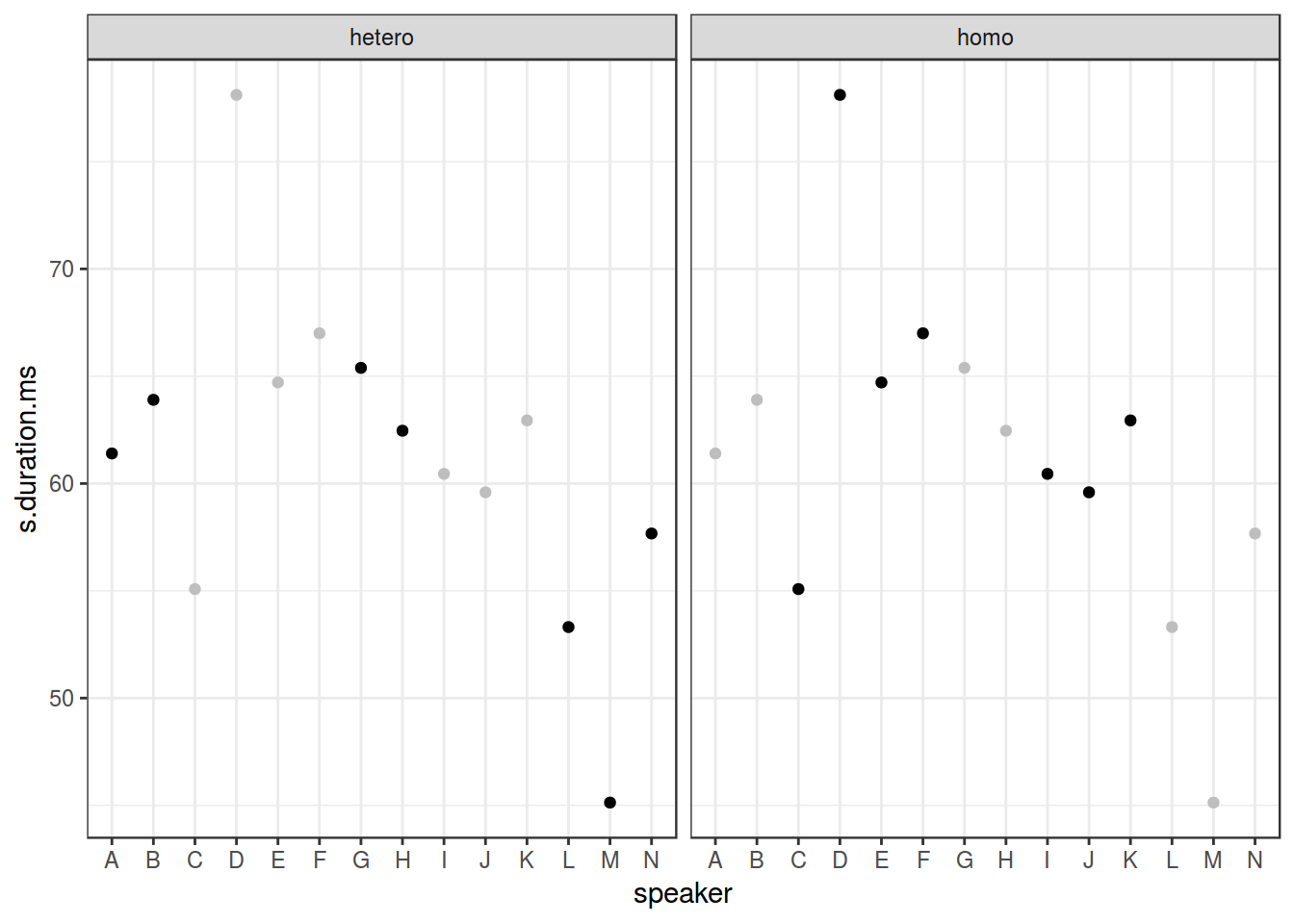- tidyverse
Г. Мороз
1. Введение
tidyverse — это набор пакетов:
- dplyr, для преобразованиия данных
- ggplot2, для визуализации
- tidyr, для формата tidy data
- readr, для чтения файлов в R
- purrr, для функционального программирования
- tibble, для работы с тибблами, современный вариант датафрейма
Полезно также знать:
- readxl, для чтения .xls и .xlsx
- jsonlite, для работы с JSON
- rvest, для веб-скреппинга
- lubridate, для работы с временем
- tidytext, для работы с текстами и корпусами
- broom, для перевода в tidy формат статистические модели
library(tidyverse)## ── Attaching packages ────────────────────────────────────────────────────── tidyverse 1.2.1 ──## ✔ ggplot2 2.2.1 ✔ purrr 0.2.4
## ✔ tibble 1.4.2 ✔ dplyr 0.7.4
## ✔ tidyr 0.8.0 ✔ stringr 1.3.0
## ✔ readr 1.1.1 ✔ forcats 0.3.0## ── Conflicts ───────────────────────────────────────────────────────── tidyverse_conflicts() ──
## ✖ dplyr::filter() masks stats::filter()
## ✖ dplyr::lag() masks stats::lag()2. tible
head(iris)
as_tibble(iris)
data_frame(id = 1:12,
letters = month.name)3. Чтение файлов: readr, readxl
library(readr)
df <- read_csv("https://goo.gl/v7nvho")
head(df)df <- read_tsv("https://goo.gl/33r2Ut")
head(df)df <- read_delim("https://goo.gl/33r2Ut", delim = "\t")
head(df)library(readxl)
xlsx_example <- readxl_example("datasets.xlsx")
df <- read_excel(xlsx_example)
head(df)excel_sheets(xlsx_example)## [1] "iris" "mtcars" "chickwts" "quakes"df <- read_excel(xlsx_example, sheet = "mtcars")
head(df)rm(df)4. dplyr
homo <- read_csv("http://goo.gl/Zjr9aF")
homoThe majority of examples in that presentation are based on Hau 2007. Experiment consisted of a perception and judgment test aimed at measuring the correlation between acoustic cues and perceived sexual orientation. Naïve Cantonese speakers were asked to listen to the Cantonese speech samples collected in Experiment and judge whether the speakers were gay or heterosexual. There are 14 speakers and following parameters:
- [s] duration (s.duration.ms)
- vowel duration (vowel.duration.ms)
- fundamental frequencies mean (F0) (average.f0.Hz)
- fundamental frequencies range (f0.range.Hz)
- percentage of homosexual impression (perceived.as.homo)
- percentage of heterosexal impression (perceived.as.hetero)
- speakers orientation (orientation)
- speakers age (age)
4.1 dplyr::filter()
How many speakers are older than 28?
homo %>%
filter(age > 28, s.duration.ms < 60)%>% — конвеер (pipe) отправляет результат работы одной функции в другую.
sort(sqrt(abs(sin(1:22))), decreasing = TRUE)## [1] 0.9999951 0.9952926 0.9946649 0.9805088 0.9792468 0.9554817 0.9535709
## [8] 0.9173173 0.9146888 0.8699440 0.8665952 0.8105471 0.8064043 0.7375779
## [15] 0.7325114 0.6482029 0.6419646 0.5365662 0.5285977 0.3871398 0.3756594
## [22] 0.09408141:22 %>%
sin() %>%
abs() %>%
sqrt() %>%
sort(., decreasing = TRUE) # зачем здесь точка?## [1] 0.9999951 0.9952926 0.9946649 0.9805088 0.9792468 0.9554817 0.9535709
## [8] 0.9173173 0.9146888 0.8699440 0.8665952 0.8105471 0.8064043 0.7375779
## [15] 0.7325114 0.6482029 0.6419646 0.5365662 0.5285977 0.3871398 0.3756594
## [22] 0.0940814Конвееры в tidyverse пришли из пакета magrittr. Иногда они работают не корректно с функциями не из tidyverse.
4.2 dplyr::slice()
homo %>%
slice(3:7)4.3 dplyr::select()
homo %>%
select(8:10)homo %>%
select(speaker:average.f0.Hz)homo %>%
select(-speaker)homo %>%
select(-c(speaker, perceived.as.hetero, perceived.as.homo, perceived.as.homo.percent))homo %>%
select(speaker, age, s.duration.ms)4.4 dplyr::arrange()
homo %>%
arrange(orientation, desc(age))4.5 dplyr::distinct()
homo %>%
distinct(orientation)homo %>%
distinct(orientation, age > 20)4.6 dplyr::mutate()
homo %>%
mutate(f0.mn = average.f0.Hz - f0.range.Hz/2,
f0.mx = (average.f0.Hz + f0.range.Hz/2))4.7 dplyr::group_by(...) %>% summarise(...)
homo %>%
summarise(min(age), mean(s.duration.ms))homo %>%
group_by(orientation) %>%
summarise(my_mean = mean(s.duration.ms))homo %>%
group_by(orientation) %>%
summarise(mean(s.duration.ms))homo %>%
group_by(orientation) %>%
summarise(mean_by_orientation = mean(s.duration.ms))Если нужно посчитать количество вхождений, то можно использовать функцию n() в summarise() или же функцию count():
homo %>%
group_by(orientation, age > 20) %>%
summarise(my_mean = mean(s.duration.ms), n_observations = n())homo %>%
count(orientation, age > 20)4.8 dplyr::.._join()
languages <- data_frame(
languages = c("Selkup", "French", "Chukchi", "Kashubian"),
countries = c("Russia", "France", "Russia", "Poland"),
iso = c("sel", "fra", "ckt", "pol")
)
languagescountry_population <- data_frame(
countries = c("Russia", "Poland", "Finland"),
population_mln = c(143, 38, 5))
country_populationinner_join(languages, country_population)left_join(languages, country_population)right_join(languages, country_population)anti_join(languages, country_population)anti_join(country_population, languages)full_join(country_population, languages)Существует достаточно забавный трюк, который позволяет использовать .._join() вместе с group_by() и summarise():
homo %>%
group_by(orientation, age > 20) %>%
summarise(my_mean = mean(s.duration.ms), n_observations = n())homo %>%
group_by(orientation, age > 20) %>%
summarise(my_mean = mean(s.duration.ms), n_observations = n()) %>%
left_join(homo)5. tidyr package
- Short format
df.short <- data.frame(
consonant = c("stops", "fricatives", "affricates", "nasals"),
initial = c(123, 87, 73, 7),
intervocal = c(57, 77, 82, 78),
final = c(30, 69, 12, 104))
df.short- Long format
- Short format → Long format:
tidyr::gather()
df.short <- data.frame(
consonant = c("stops", "fricatives", "affricates", "nasals"),
initial = c(123, 87, 73, 7),
intervocal = c(57, 77, 82, 78),
final = c(30, 69, 12, 104))
df.shortdf.short %>%
gather(position, number, initial:final) ->
df.long
df.long- Long format → Short format:
tidyr::spread()
df.long %>%
spread(position, number) ->
df.short
df.short6.1 Anscombe’s quartet
In Anscombe, F. J. (1973). “Graphs in Statistical Analysis” was presented the next sets of data:
quartet <- read.csv("https://goo.gl/KuuzYy")
quartetquartet %>%
group_by(dataset) %>%
summarise(mean_X = mean(x),
mean_Y = mean(y),
sd_X = sd(x),
sd_Y = sd(y),
cor = cor(x, y),
n_obs = n()) %>%
select(-dataset) %>%
round(., 2)
5.2 Datasaurus
In Matejka and Fitzmaurice (2017) “Same Stats, Different Graphs” was presented the next sets of data:
datasaurus <- read_tsv("https://goo.gl/gtaunr")
head(datasaurus)
datasaurus %>%
group_by(dataset) %>%
summarise(mean_X = mean(x),
mean_Y = mean(y),
sd_X = sd(x),
sd_Y = sd(y),
cor = cor(x, y),
n_obs = n()) %>%
select(-dataset) %>%
round(., 1)6.1 Scaterplot
- ggplot2
ggplot(data = homo, aes(s.duration.ms, vowel.duration.ms)) +
geom_point()
- dplyr, ggplot2
homo %>%
ggplot(aes(average.f0.Hz, age))+
geom_smooth(method = "lm")+
geom_point(aes(color = orientation))
6.1.1 Scaterplot: color
homo %>%
ggplot(aes(s.duration.ms, vowel.duration.ms,
color = orientation)) +
geom_point()
6.1.2 Scaterplot: shape
homo %>%
ggplot(aes(s.duration.ms, vowel.duration.ms,
shape = orientation)) +
geom_point(color = "green")
6.1.3 Scaterplot: size
homo %>%
ggplot(aes(s.duration.ms, vowel.duration.ms,
size = age)) +
geom_point()
6.1.4 Scaterplot: text
homo %>%
mutate(label = ifelse(orientation == "homo","⚣", "⚤")) %>%
ggplot(aes(s.duration.ms, vowel.duration.ms, label = label, fill = orientation)) +
geom_label()
homo %>%
mutate(label = ifelse(orientation == "homo","⚣", "⚤")) %>%
ggplot(aes(s.duration.ms, vowel.duration.ms, label = label, color = orientation)) +
geom_text()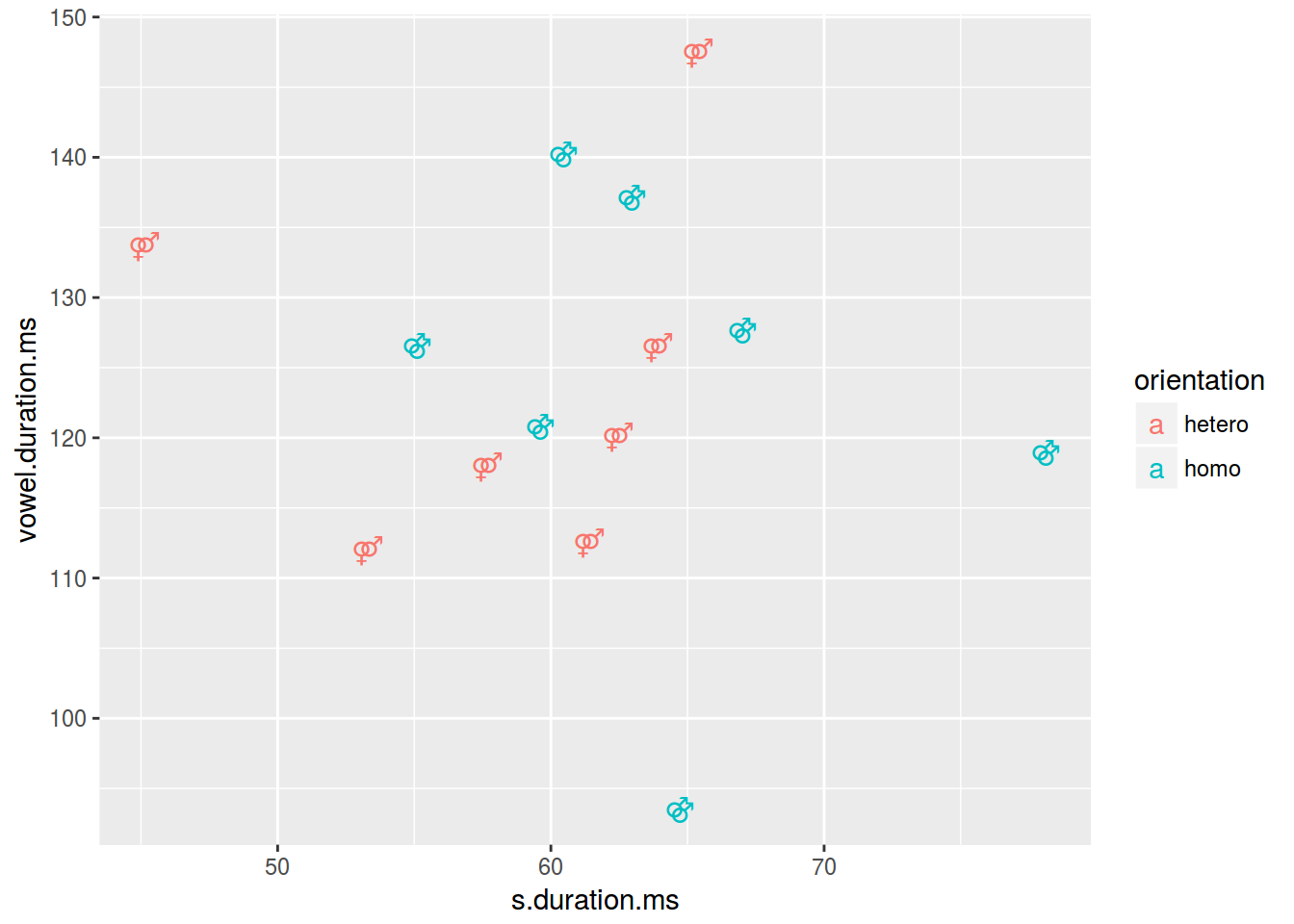
6.1.5 Scaterplot: title
homo %>%
ggplot(aes(s.duration.ms, vowel.duration.ms)) +
geom_point()+
labs(title = "length of [s] vs. length of vowels",
subtitle = "based on 14 speakers of Cantonese",
caption = "data from [Hau 2007]")
6.1.6 Scaterplot: axis
homo %>%
ggplot(aes(s.duration.ms, vowel.duration.ms)) +
geom_point()+
xlab("duration of [s] in ms")+
ylab("vowel duration in ms")
6.1.7 Log scales

Lets use the frequency dictionary for Russian
freq <- read.csv("https://goo.gl/TlX7xW", sep = "\t")
freq %>%
arrange(desc(Freq.ipm.)) %>%
slice(1:200) %>%
ggplot(aes(Rank, Freq.ipm.)) +
geom_point() +
xlab("") +
ylab("ipm")
freq %>%
ggplot(aes(1:52138, Freq.ipm.))+
geom_point()+
xlab("")+
ylab("ipm")+
scale_y_log10()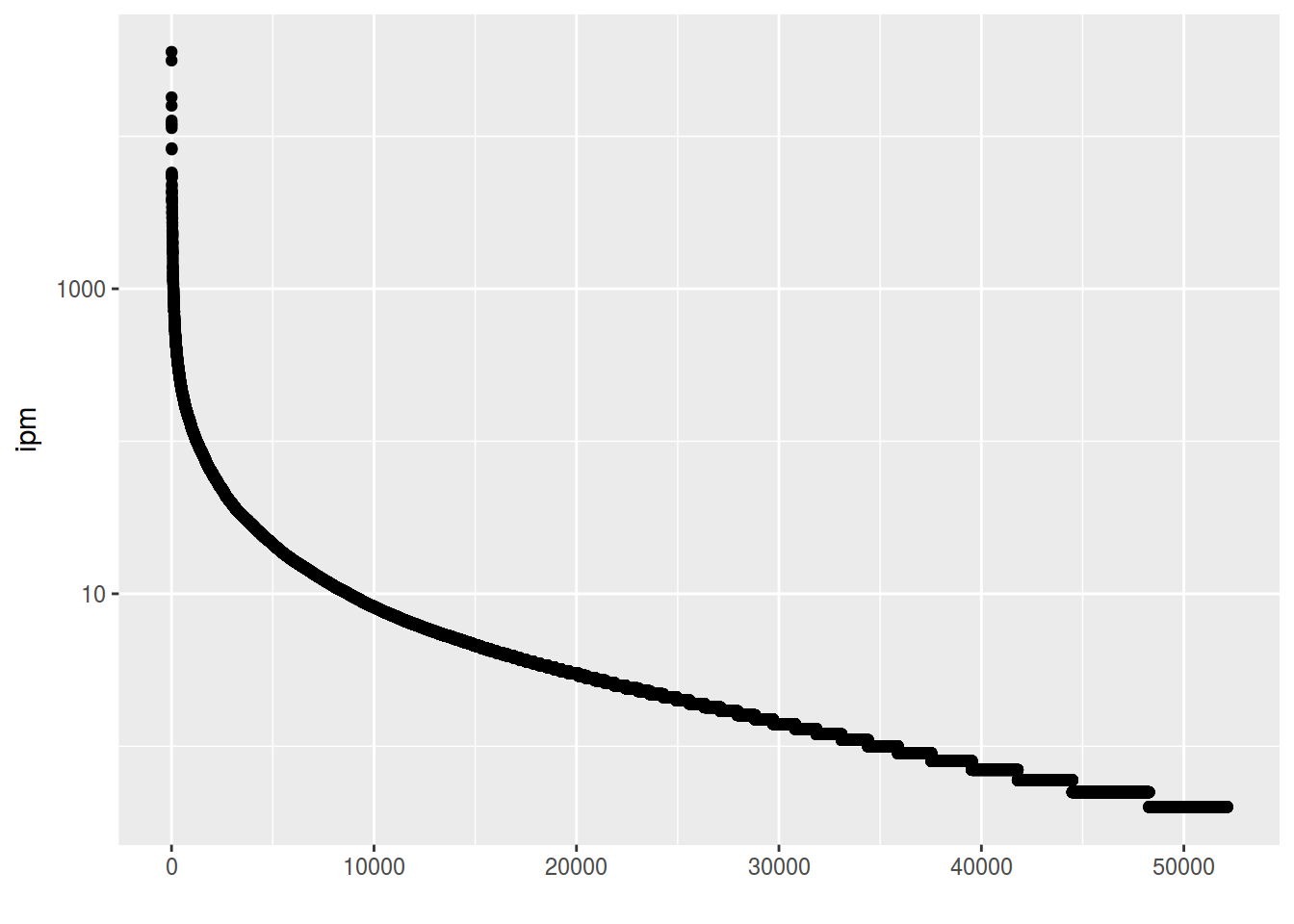
6.1.8 Scaterplot: rug
homo %>%
ggplot(aes(s.duration.ms, vowel.duration.ms, color = orientation)) +
geom_point() +
geom_rug()
6.1.9 Scaterplot: lines
homo %>%
ggplot(aes(s.duration.ms, vowel.duration.ms)) +
geom_point() +
geom_hline(yintercept = mean(homo$vowel.duration.ms))+
geom_vline(xintercept = 60)
homo %>%
ggplot(aes(s.duration.ms, vowel.duration.ms)) +
geom_point() +
geom_hline(yintercept = 120, linetype = 2)+
geom_vline(xintercept = 60, size = 5)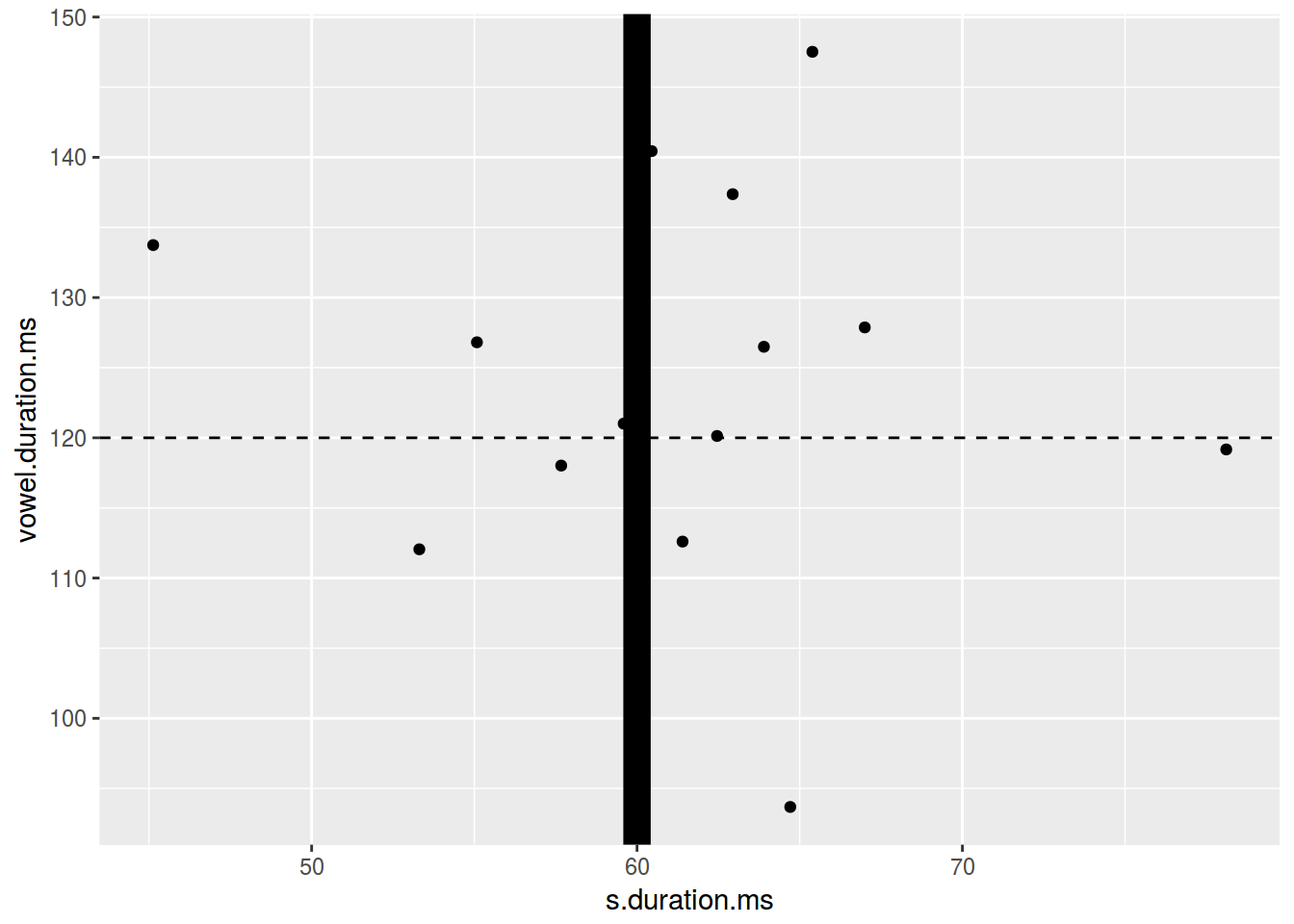
homo %>%
ggplot(aes(s.duration.ms, vowel.duration.ms)) +
geom_point() +
geom_hline(yintercept = 120, linetype = 4)+
geom_vline(xintercept = 60, color = "blue")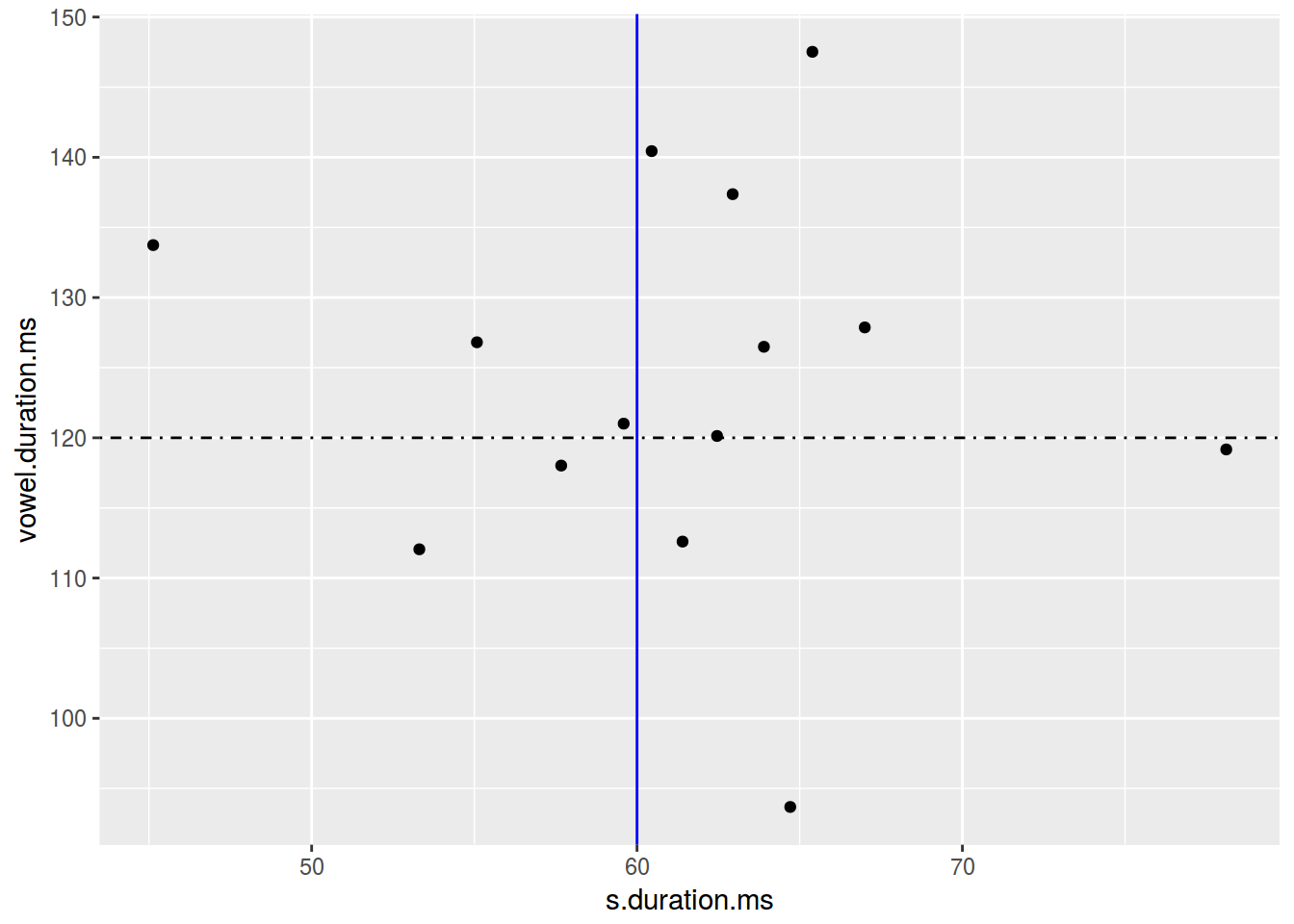
6.1.10 Scaterplot: annotate
Функция annotate добавляет geom к графику.
homo %>%
ggplot(aes(s.duration.ms, vowel.duration.ms)) +
geom_point()+
annotate(geom = "rect", xmin = 77, xmax = 79,
ymin = 117, ymax = 122, fill = "red", alpha = 0.2) +
annotate(geom = "text", x = 78, y = 125,
label = "Who is that?\n Outlier?")
6.2.1 Barplots: basics
There are two possible situations:
- not aggregate data
head(homo[, c(1, 9)])- aggregate data
head(homo[, c(1, 10)])homo %>%
ggplot(aes(orientation)) +
geom_bar()
homo %>%
ggplot(aes(speaker, age)) +
geom_col()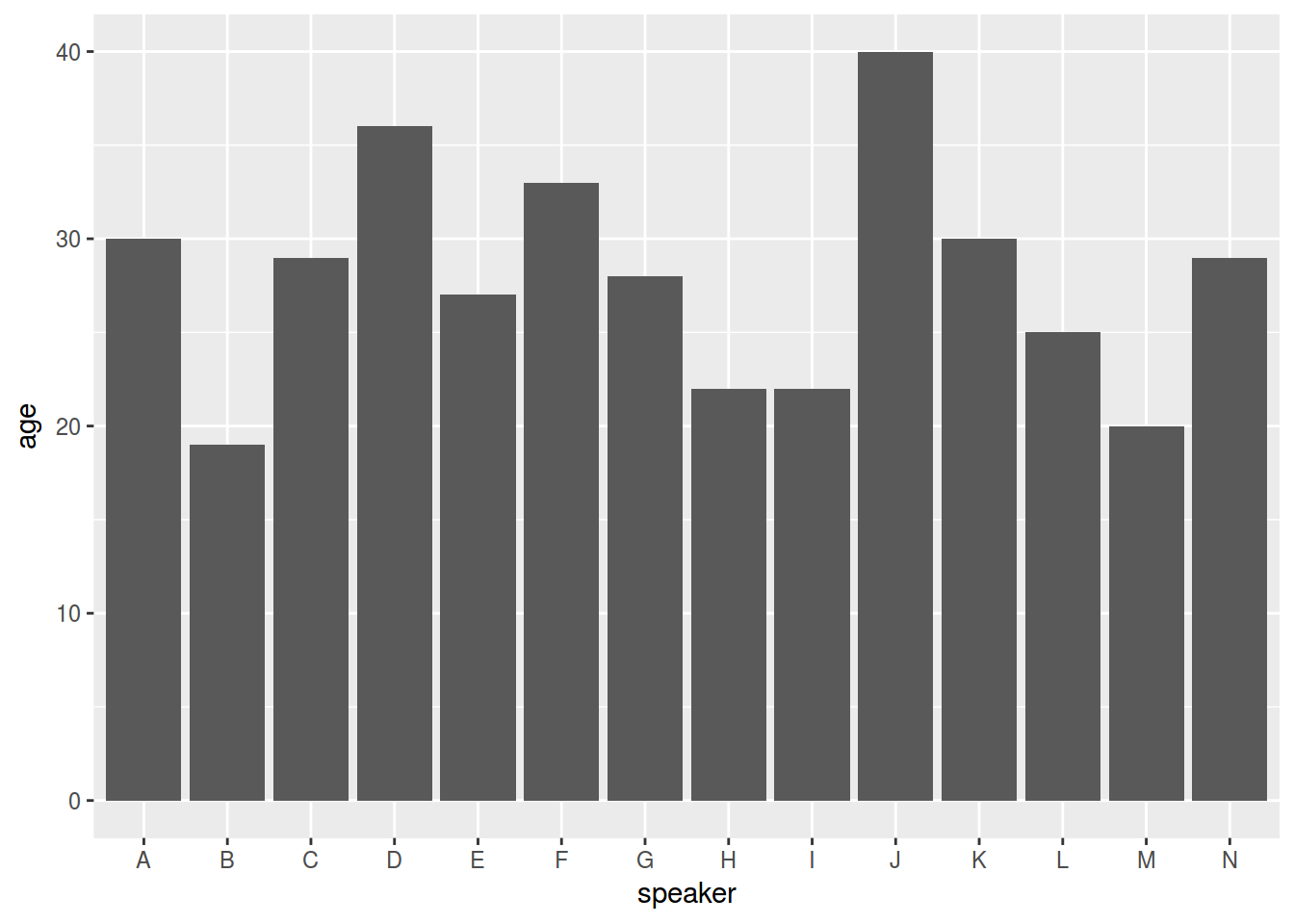
homo %>%
ggplot(aes(speaker, age, fill = orientation)) +
geom_col()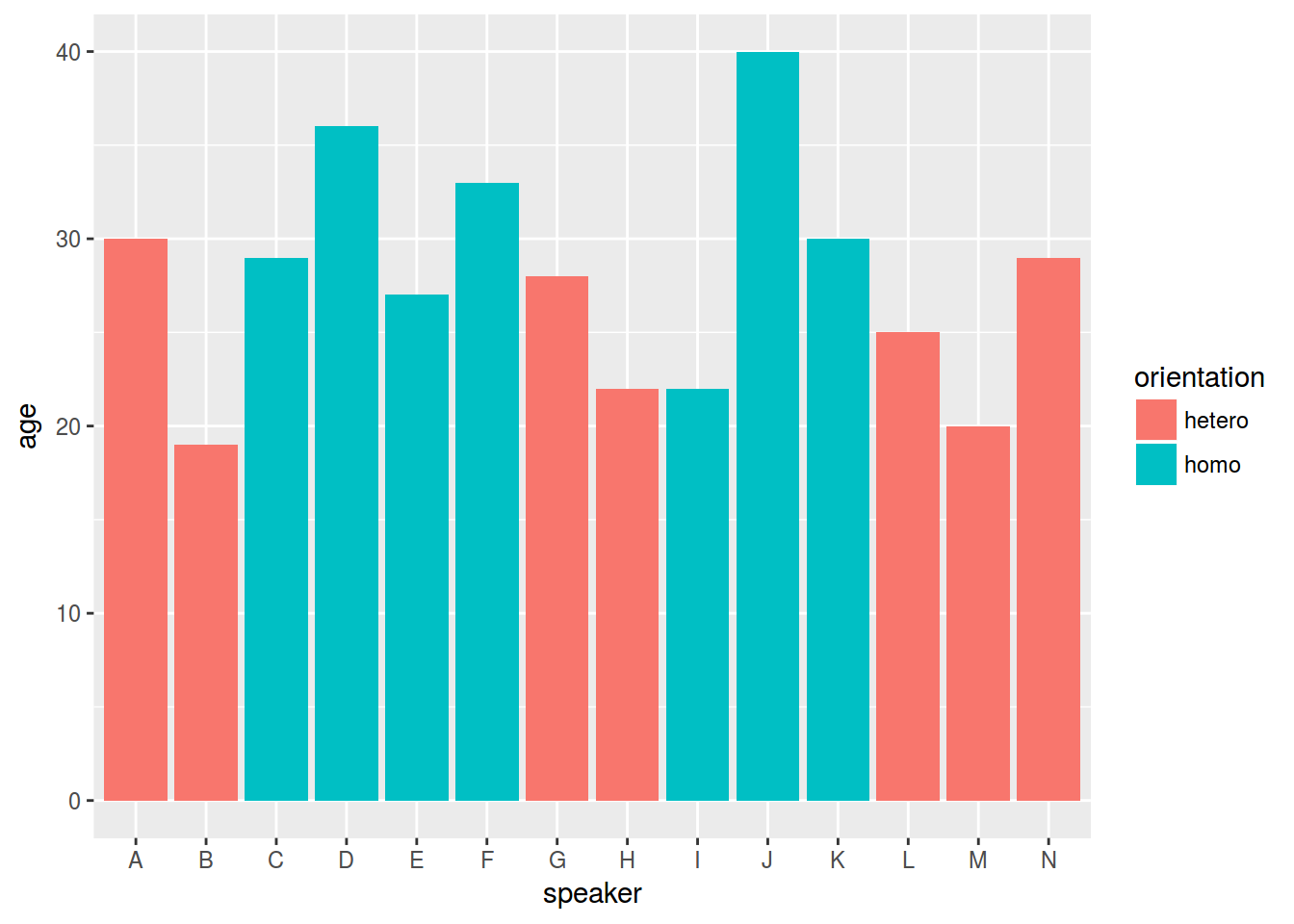
6.3.1 Boxplots: basics, points, jitter
homo %>%
ggplot(aes(orientation, s.duration.ms)) +
geom_boxplot()
homo %>%
ggplot(aes(orientation, s.duration.ms)) +
geom_boxplot()+
geom_point()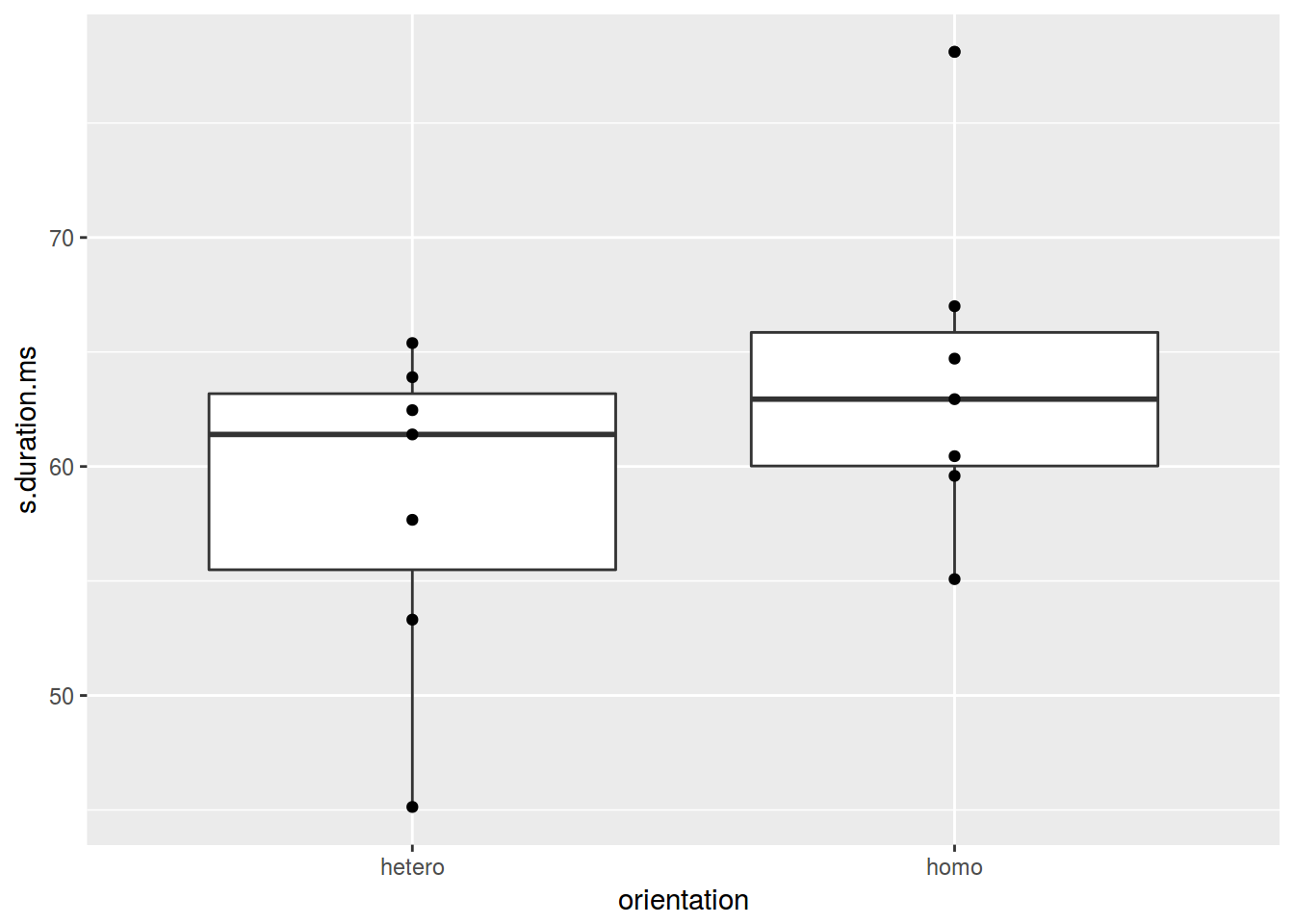
homo %>%
ggplot(aes(orientation, s.duration.ms)) +
geom_boxplot() +
geom_jitter(width = 0.5)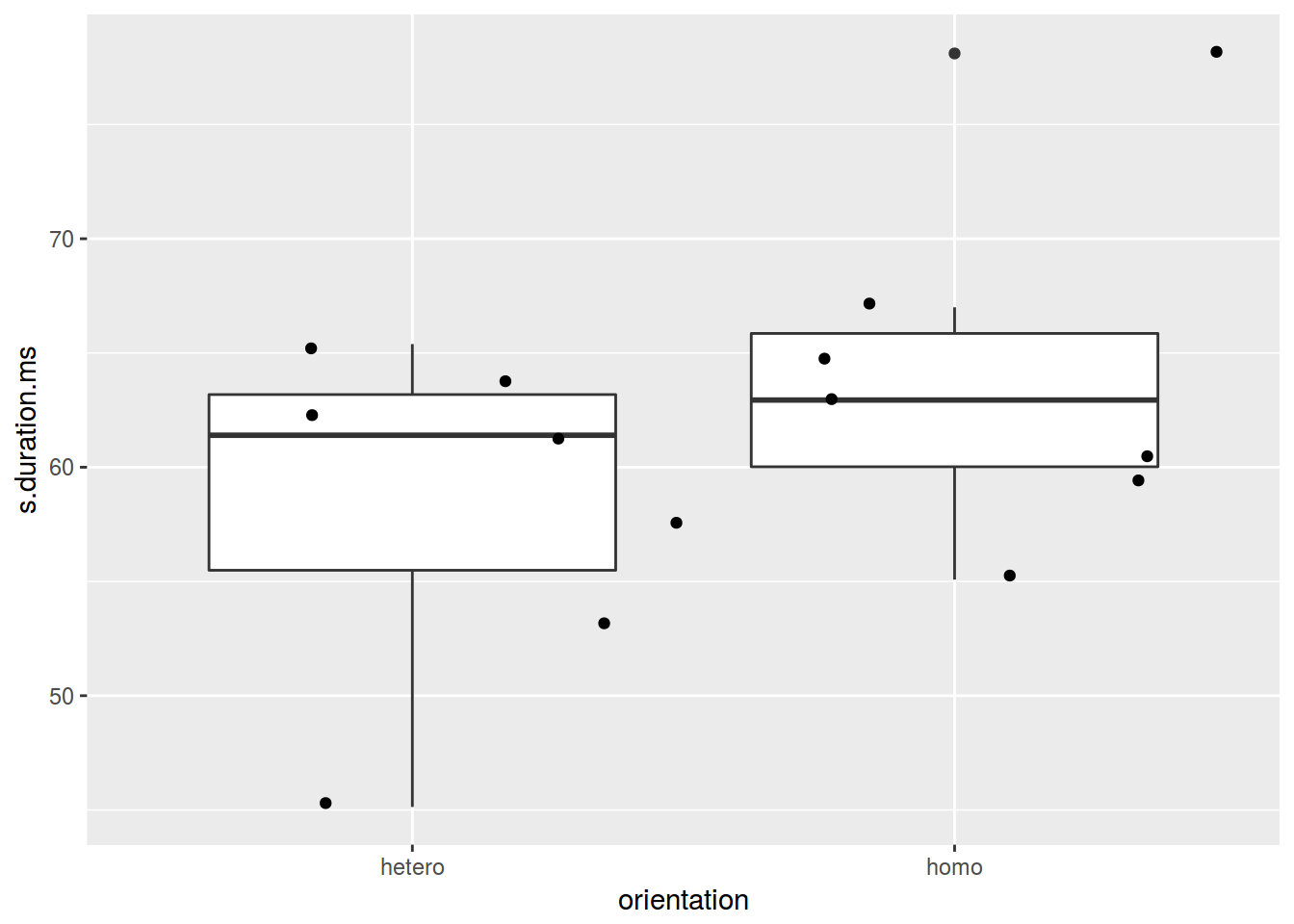
homo %>%
ggplot(aes(orientation, s.duration.ms)) +
geom_violin() +
geom_jitter()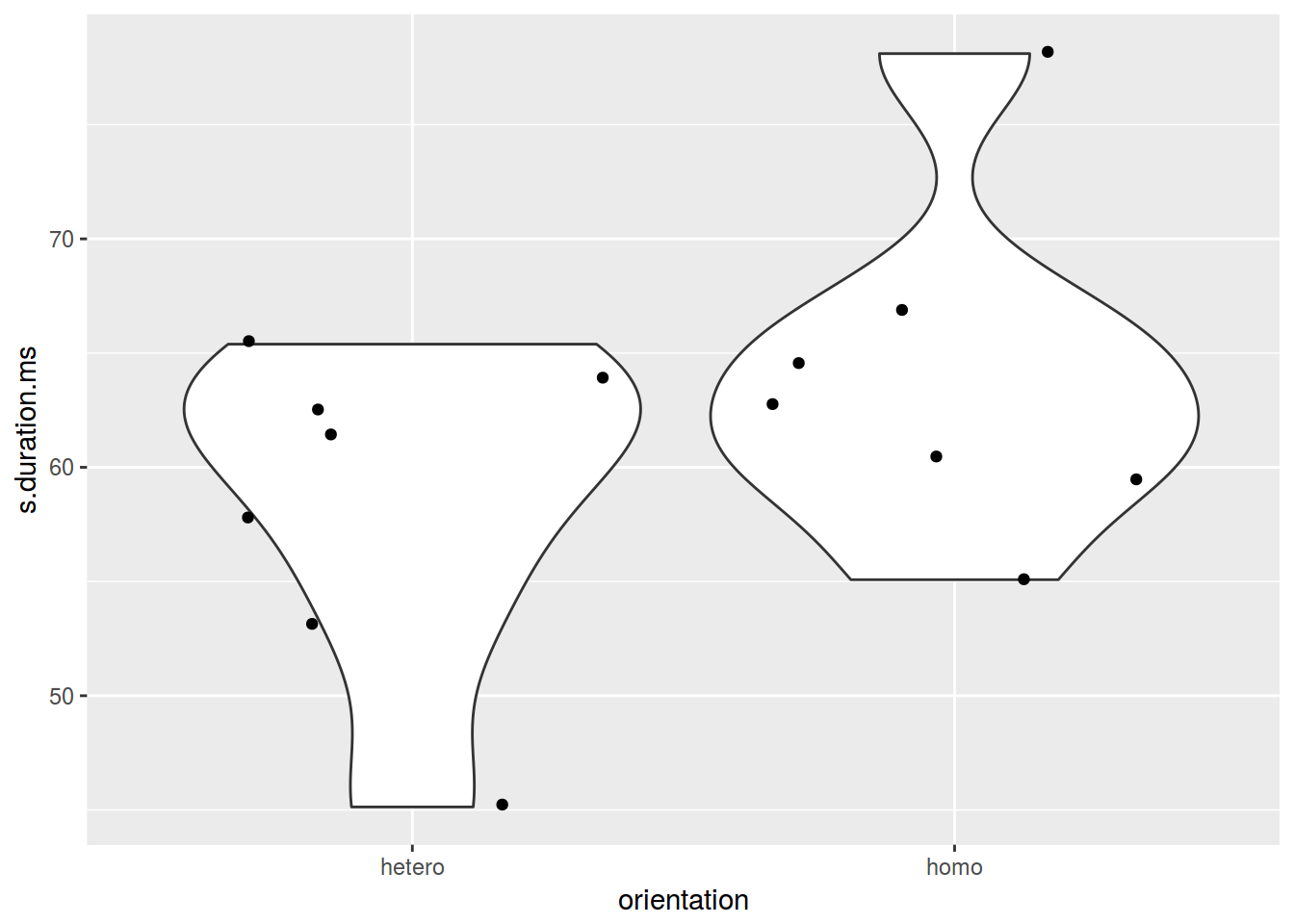
6. Preliminary summary: two variables
- scaterplot: two quantitative varibles
- barplot: nominal varible and one number
- boxplot: nominal varible and quantitative varibles
- jittered points or sized points: two nominal varibles
mtcars %>%
mutate(newvar = mpg > 22,
newvr = mpg < 17) %>%
ggplot(aes(newvr, newvar, color = newvar))+
geom_jitter(width = 0.2)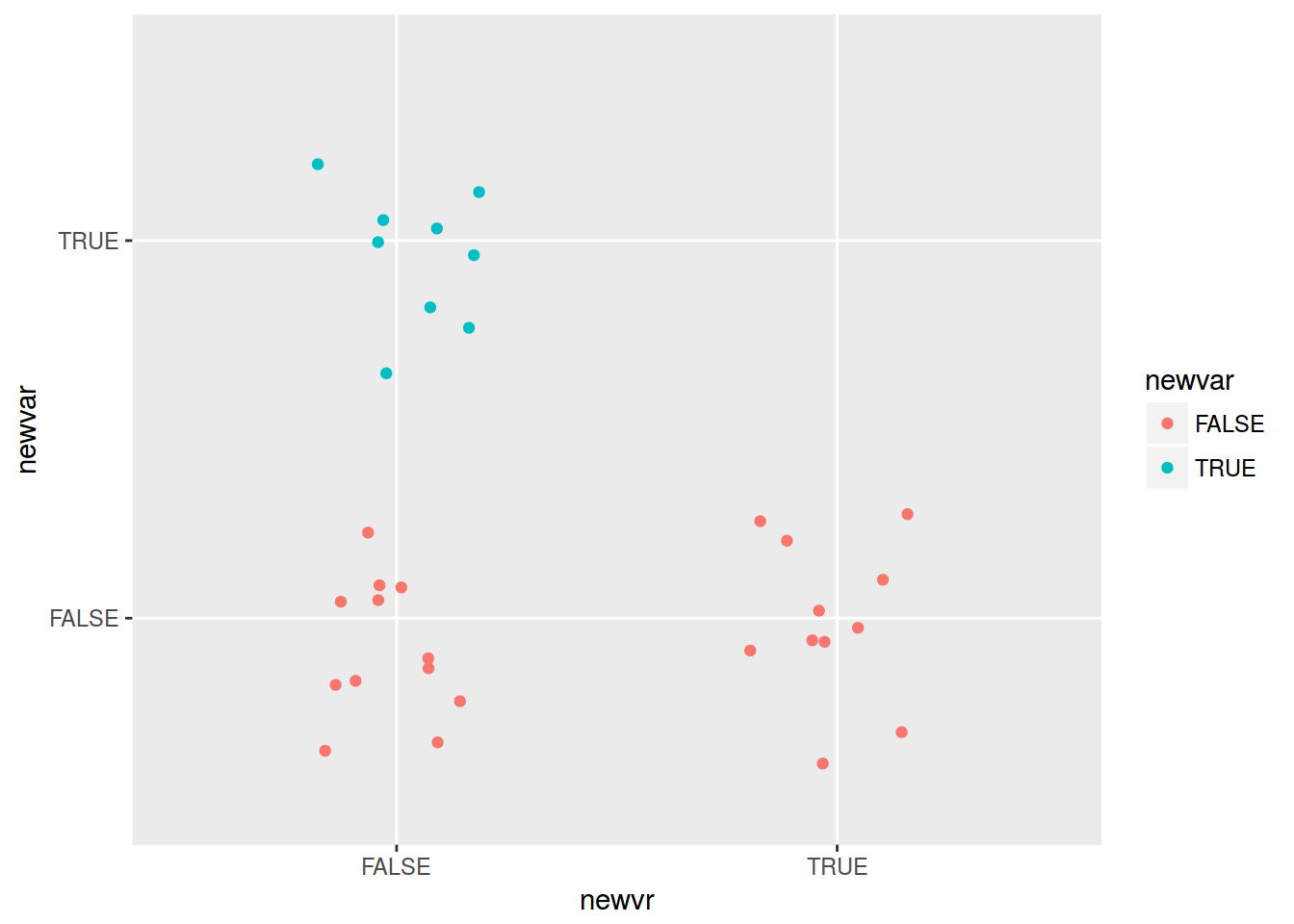
mtcars %>%
mutate(newvar = mpg > 22,
newvr = mpg < 17) %>%
group_by(newvar, newvr) %>%
summarise(number = n()) %>%
ggplot(aes(newvr, newvar, label = number))+
geom_point(aes(size = number, color = newvar))+
geom_text()+
scale_size(range = c(10, 30))+
guides(size = F)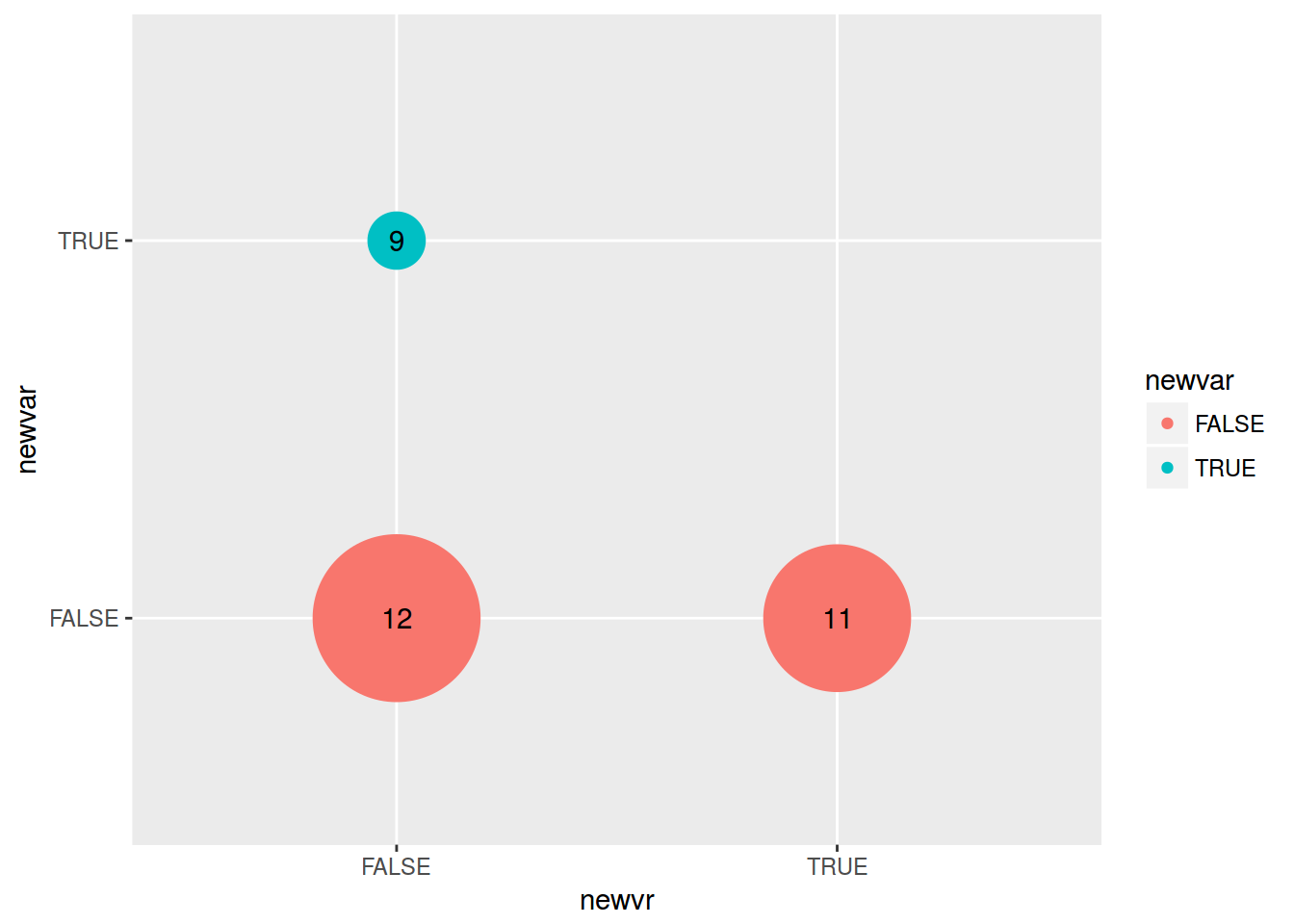
6.4.1 Histogram: basics
homo %>%
ggplot(aes(s.duration.ms)) +
geom_histogram() How many histogram bins do we need?
How many histogram bins do we need?
- [Sturgers 1926]
nclass.Sturges(homo$s.duration.ms) - [Scott 1979]
nclass.scott(homo$s.duration.ms) - [Freedman, Diaconis 1981]
nclass.FD(homo$s.duration.ms)
homo %>%
ggplot(aes(s.duration.ms)) +
geom_histogram(bins = nclass.FD(homo$s.duration.ms))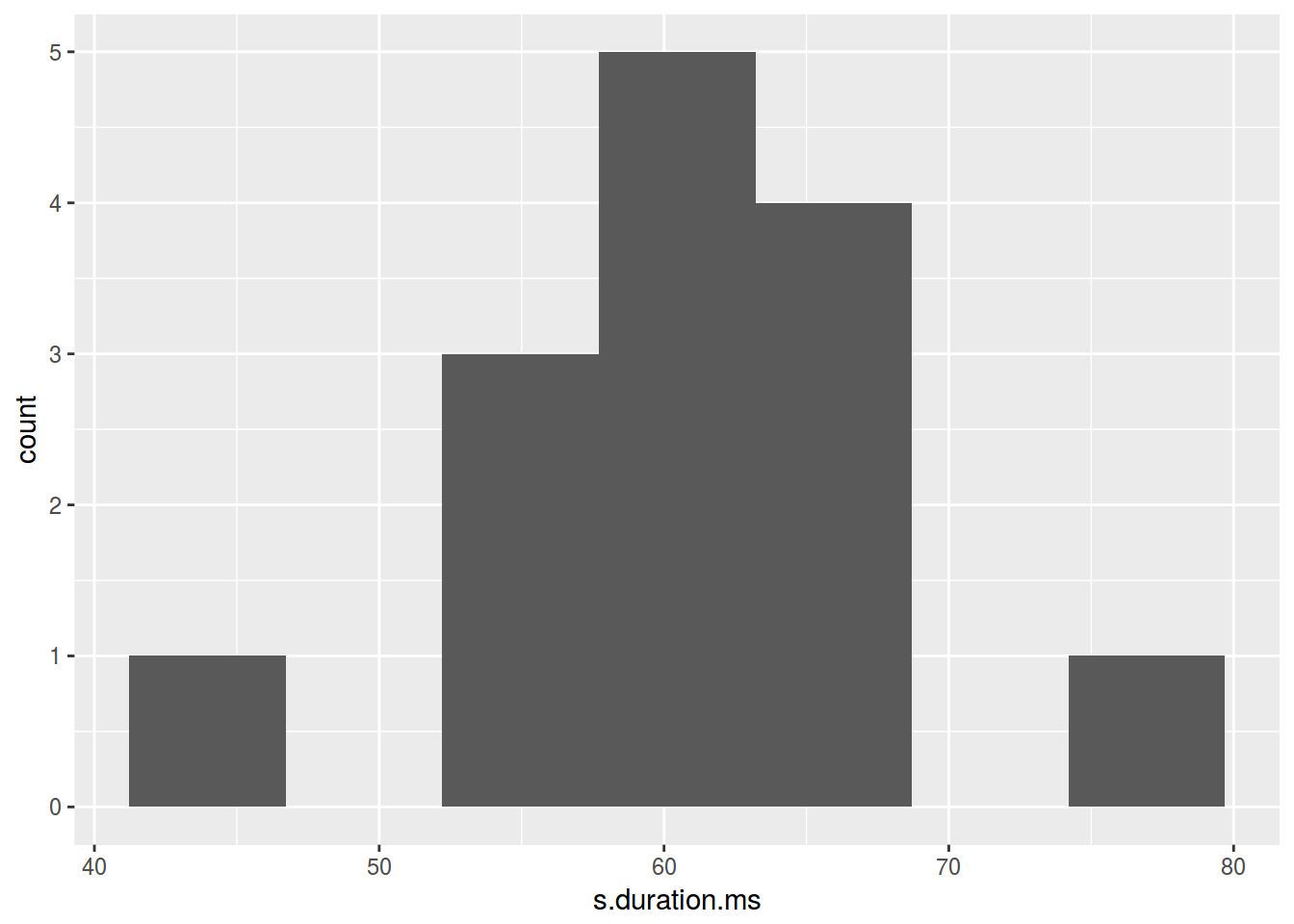
homo %>%
ggplot(aes(s.duration.ms)) +
geom_histogram(fill = "lightblue")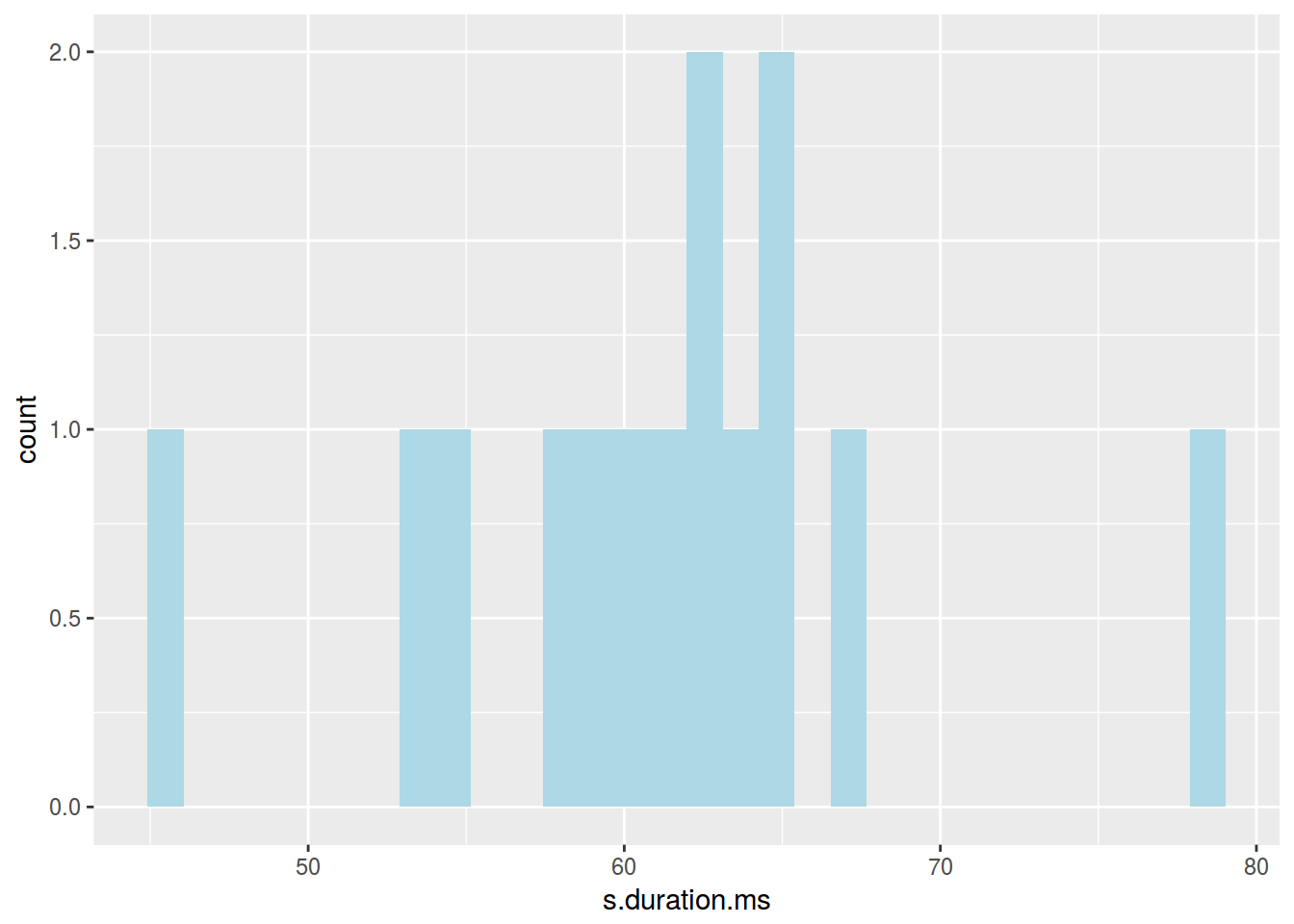
6.5.1 Density plot
homo %>%
ggplot(aes(s.duration.ms)) +
geom_density()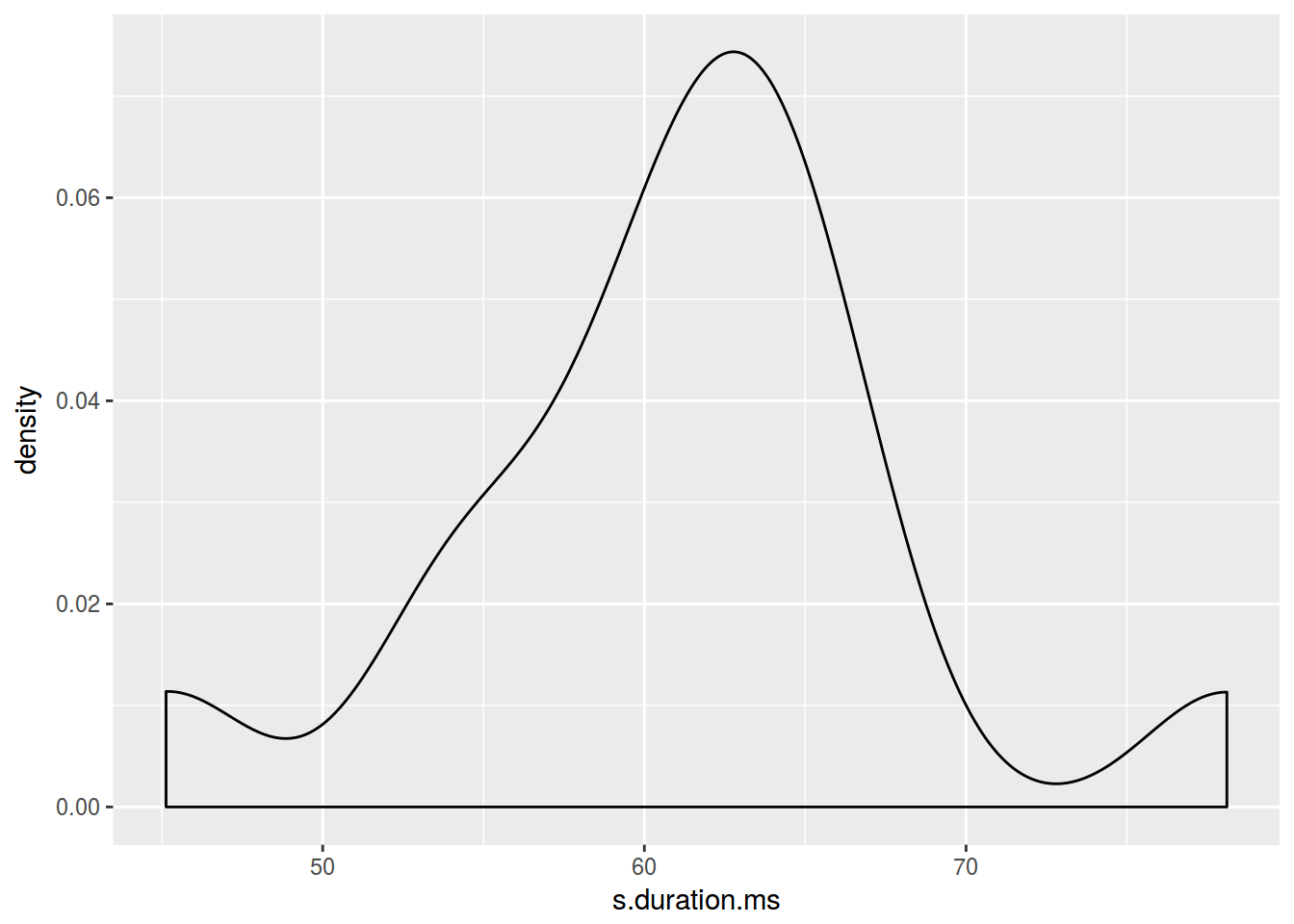
homo %>%
ggplot(aes(s.duration.ms)) +
geom_density(color = "blue")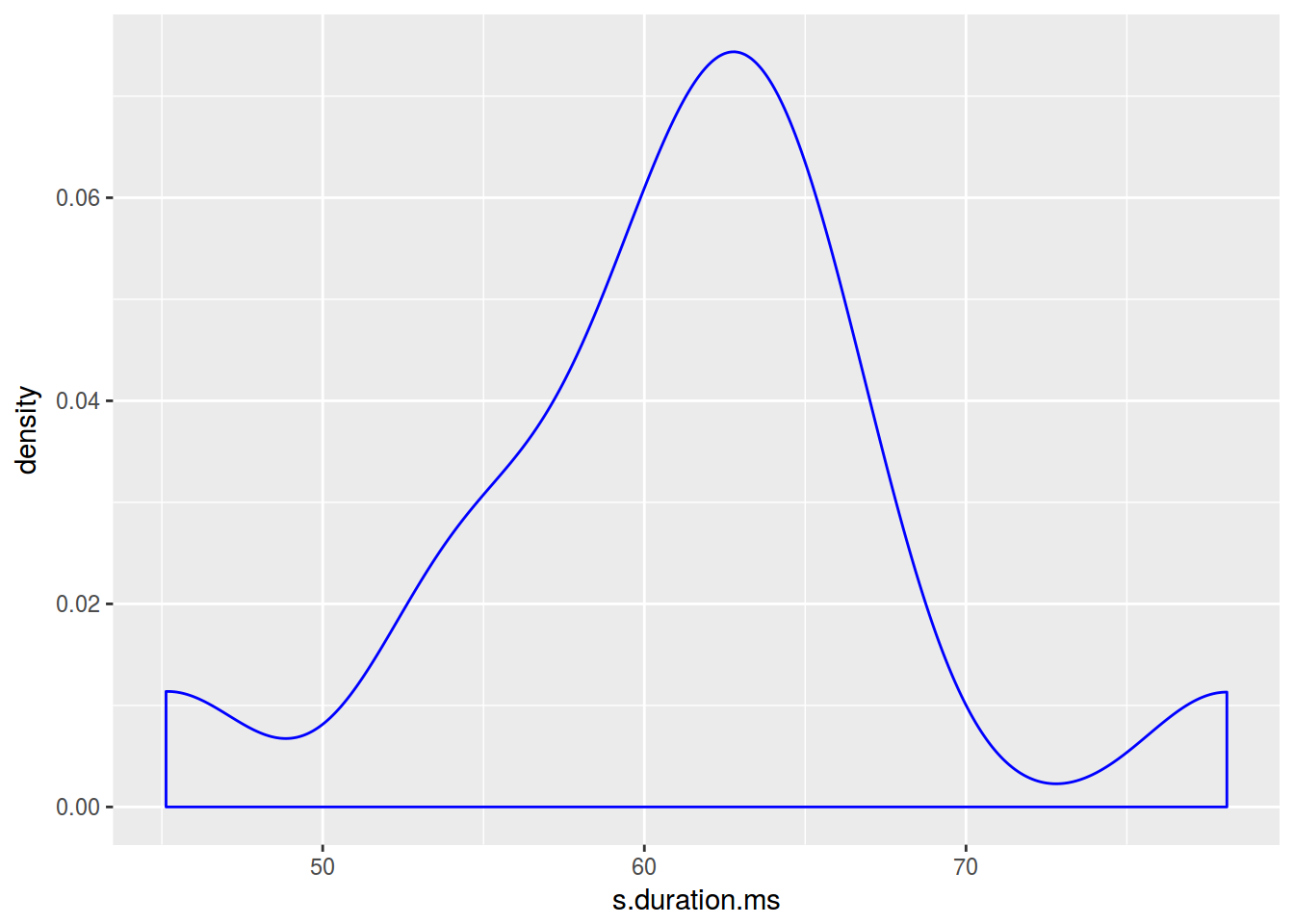
homo %>%
ggplot(aes(s.duration.ms)) +
geom_density(fill = "lightblue")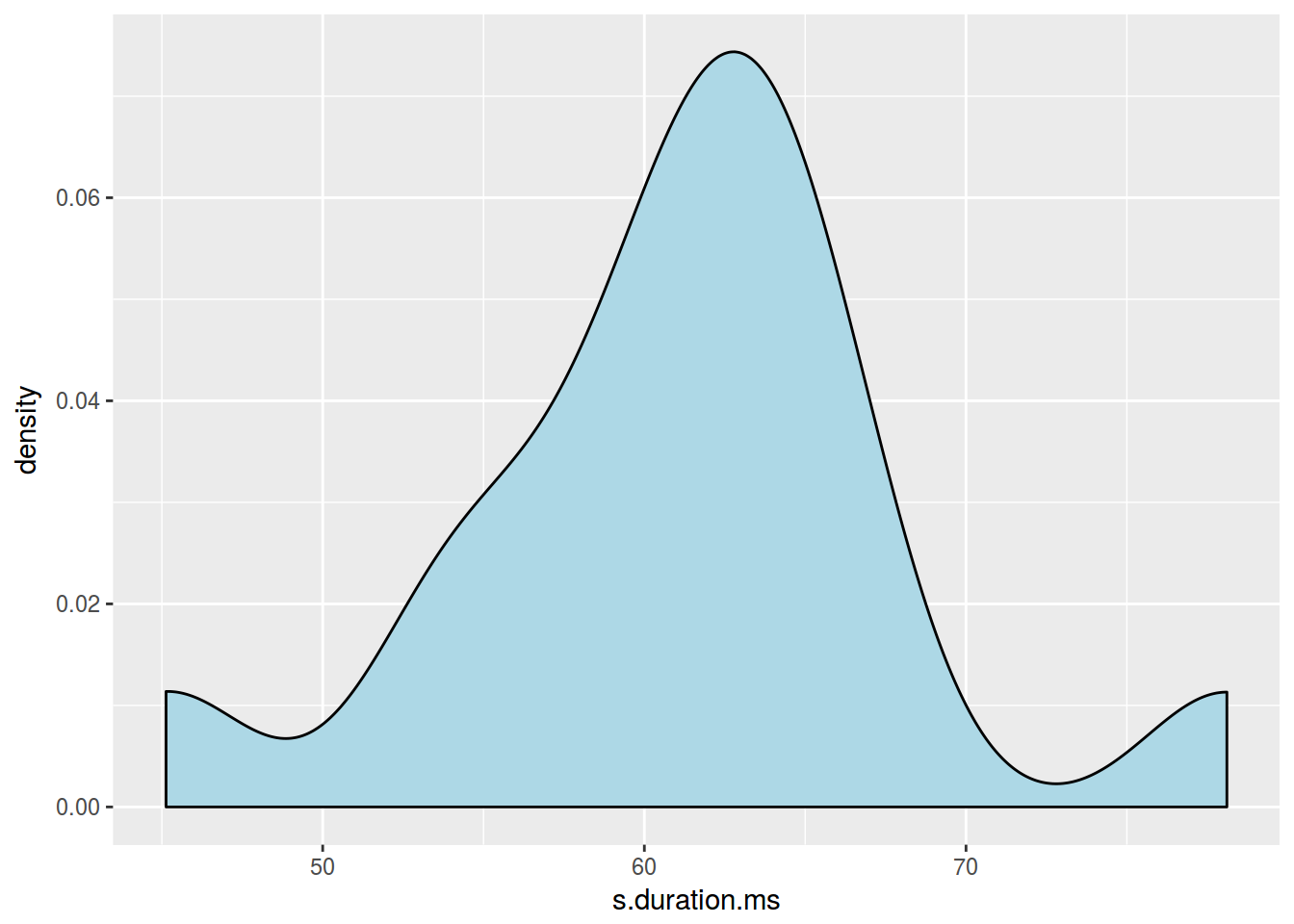
homo %>%
ggplot(aes(s.duration.ms, fill = orientation)) +
geom_density()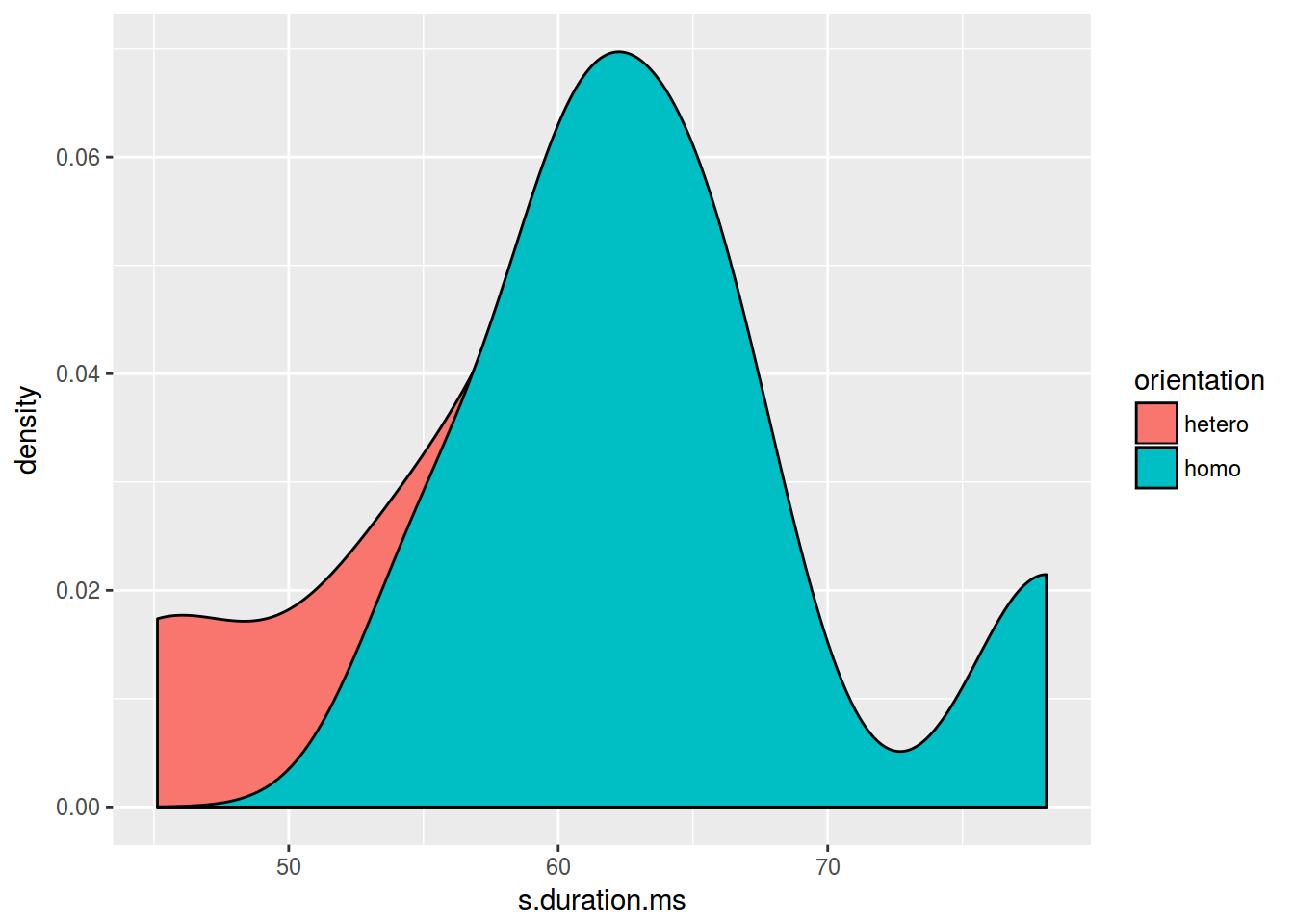
homo %>%
ggplot(aes(s.duration.ms, fill = orientation)) +
geom_density(alpha = 0.2)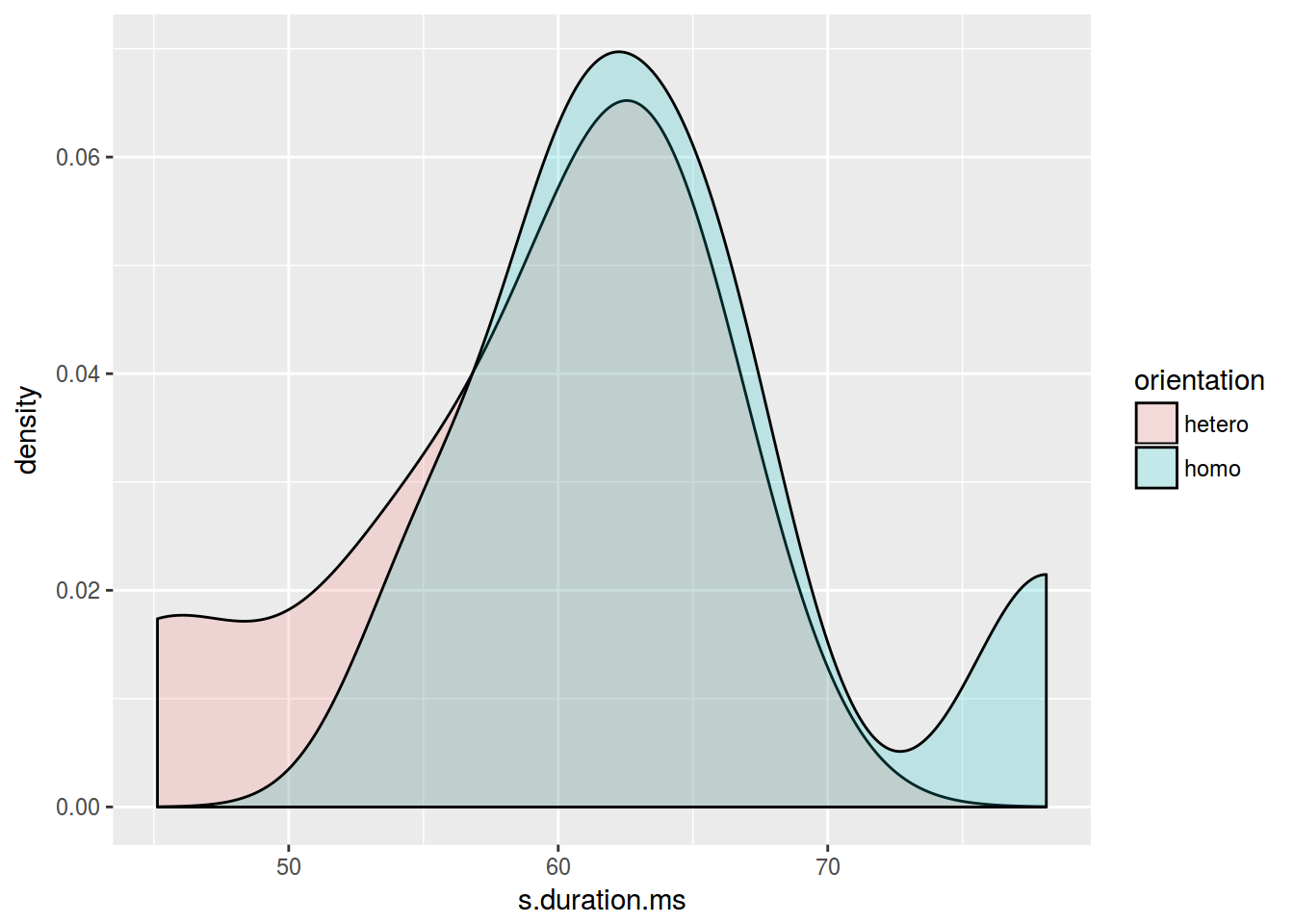
library(ggridges)
homo %>%
ggplot(aes(s.duration.ms, orientation, fill = orientation)) +
geom_density_ridges()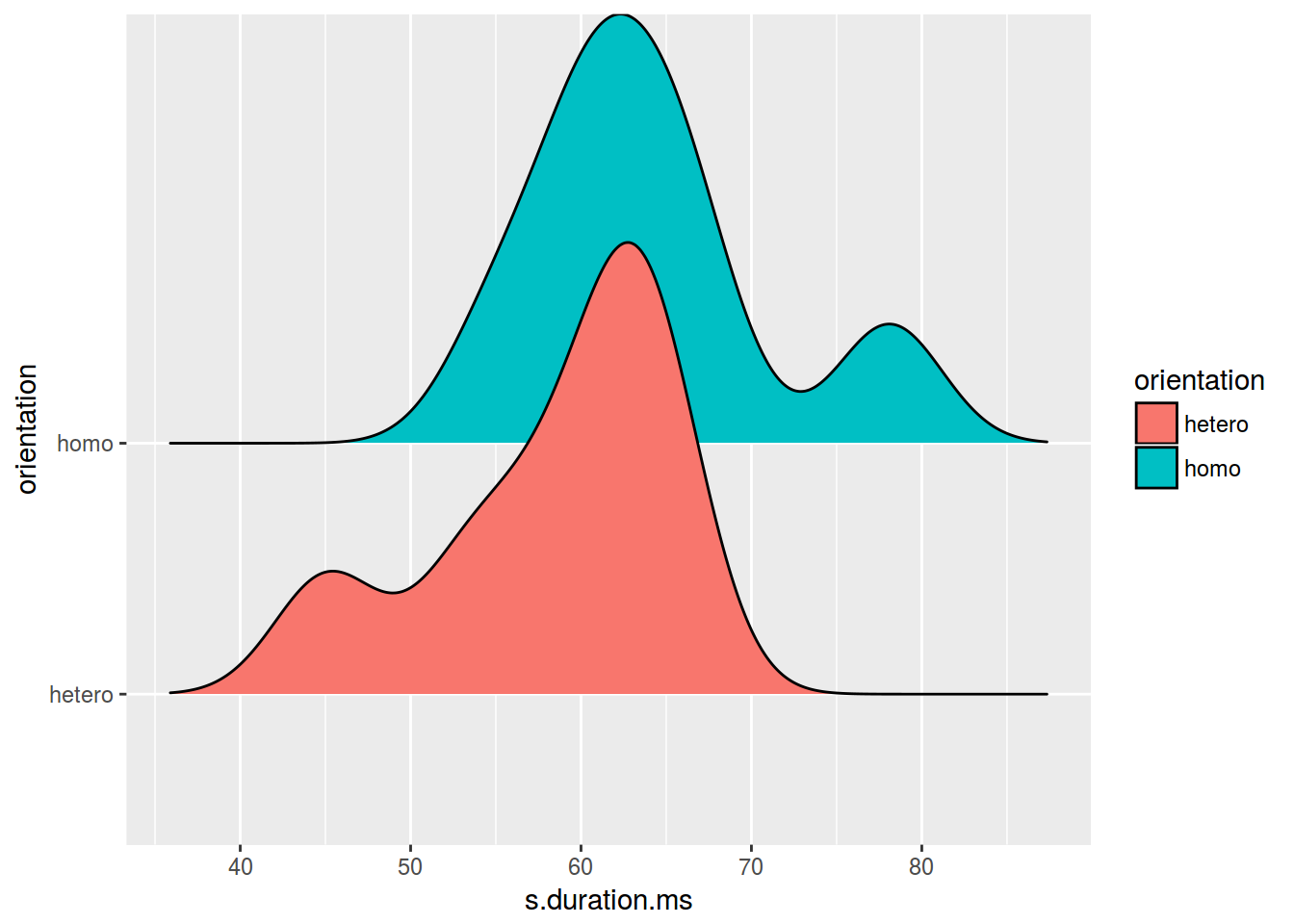
6.7 Facets
Фасетизация наиболее сильное оружие ggplot2, позволяющее разбить данные по одному или нескольким переменным и нанести награфик получившиеся подгруппы.
6.7.1 ggplot2::facet_wrap()
homo %>%
ggplot(aes(speaker, s.duration.ms))+
geom_point() +
facet_wrap(~orientation)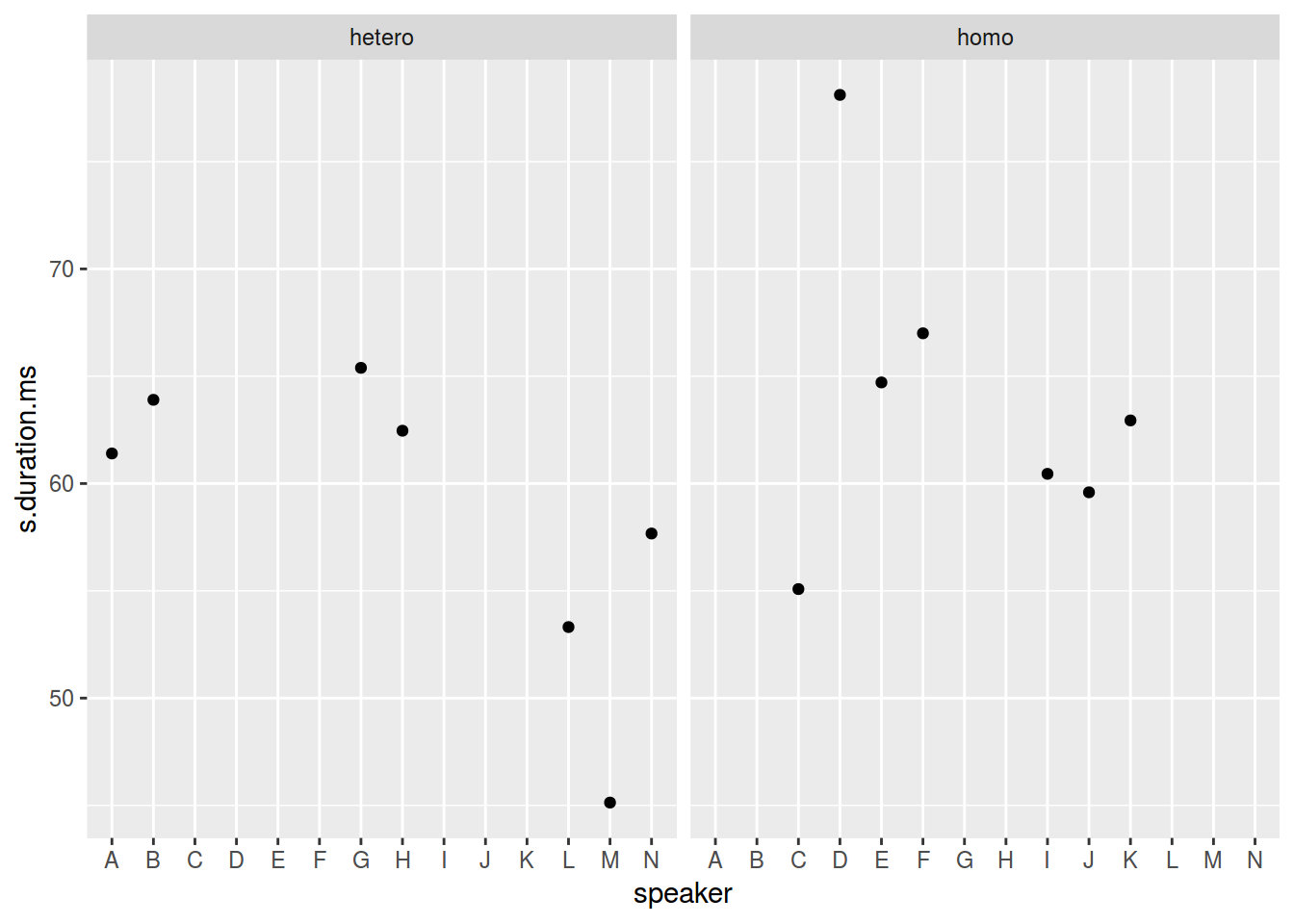
homo %>%
ggplot(aes(speaker, s.duration.ms))+
geom_point() +
facet_wrap(~orientation, scales = "free")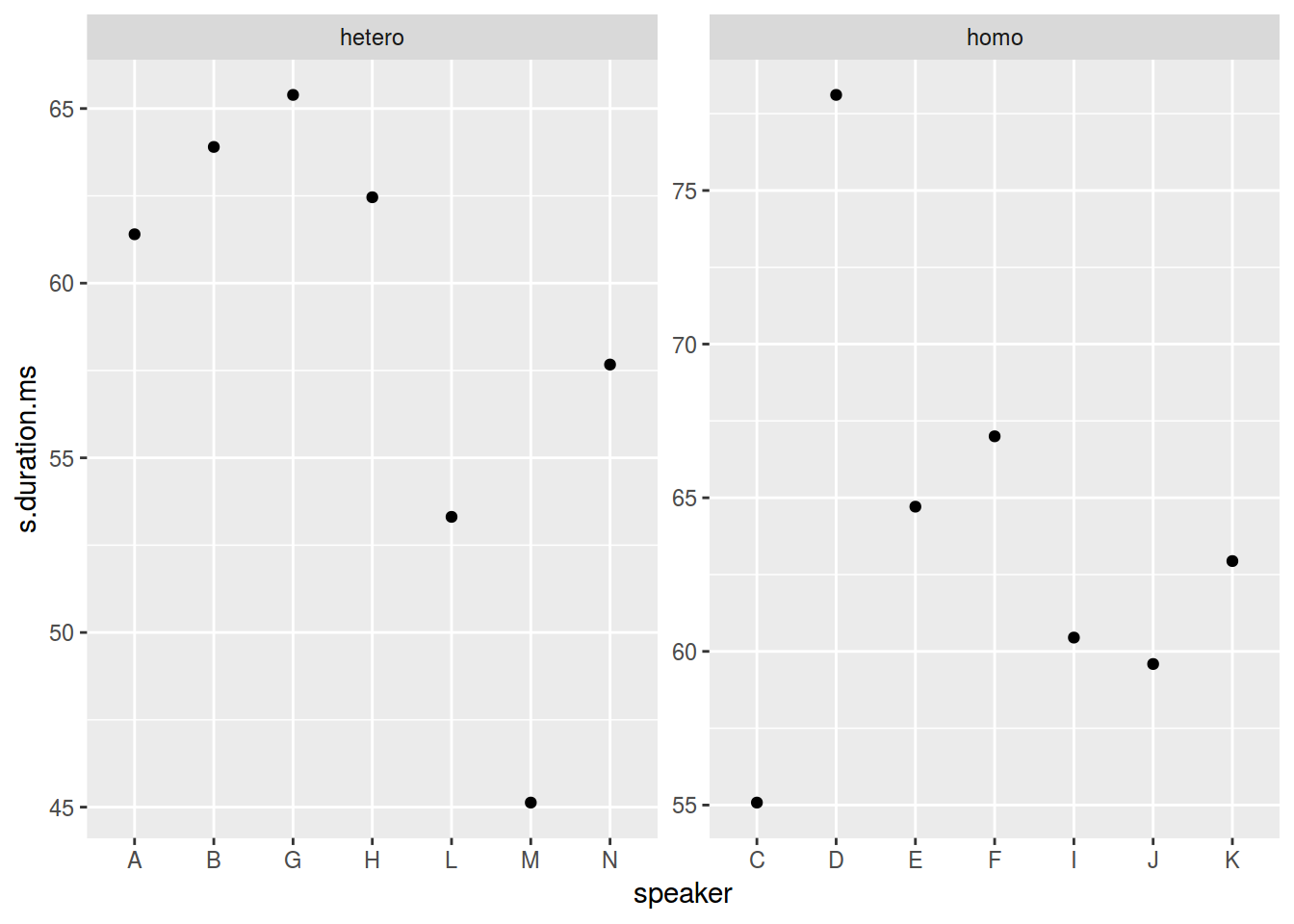
homo %>%
ggplot(aes(speaker, s.duration.ms))+
geom_point() +
facet_wrap(~orientation, scales = "free_x")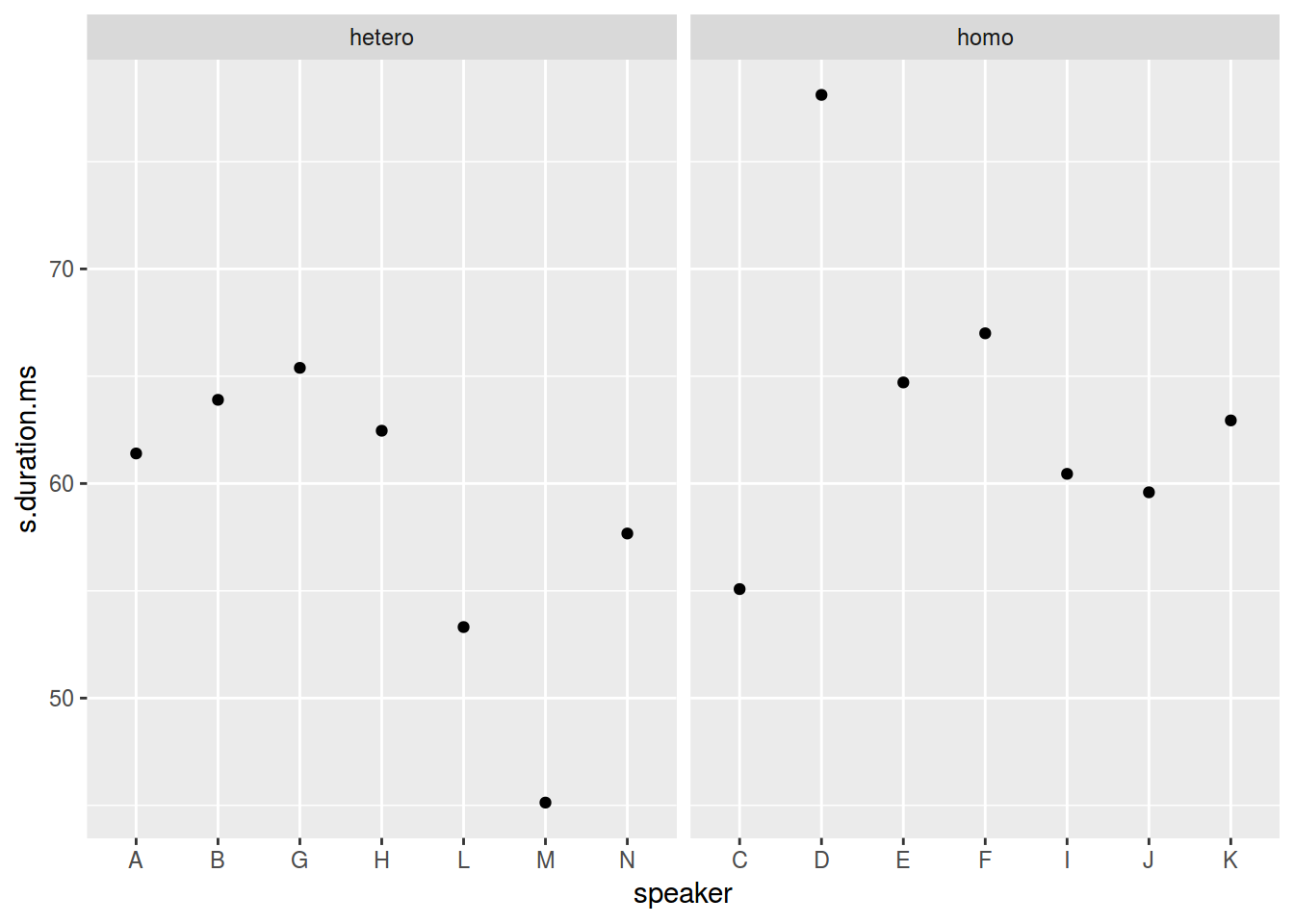
6.7.2 ggplot2::facet_grid()
homo %>%
mutate(older_then_28 = ifelse(age > 28, "older", "younger")) %>%
ggplot(aes(speaker, s.duration.ms))+
geom_point() +
facet_wrap(older_then_28~orientation, scales = "free_x")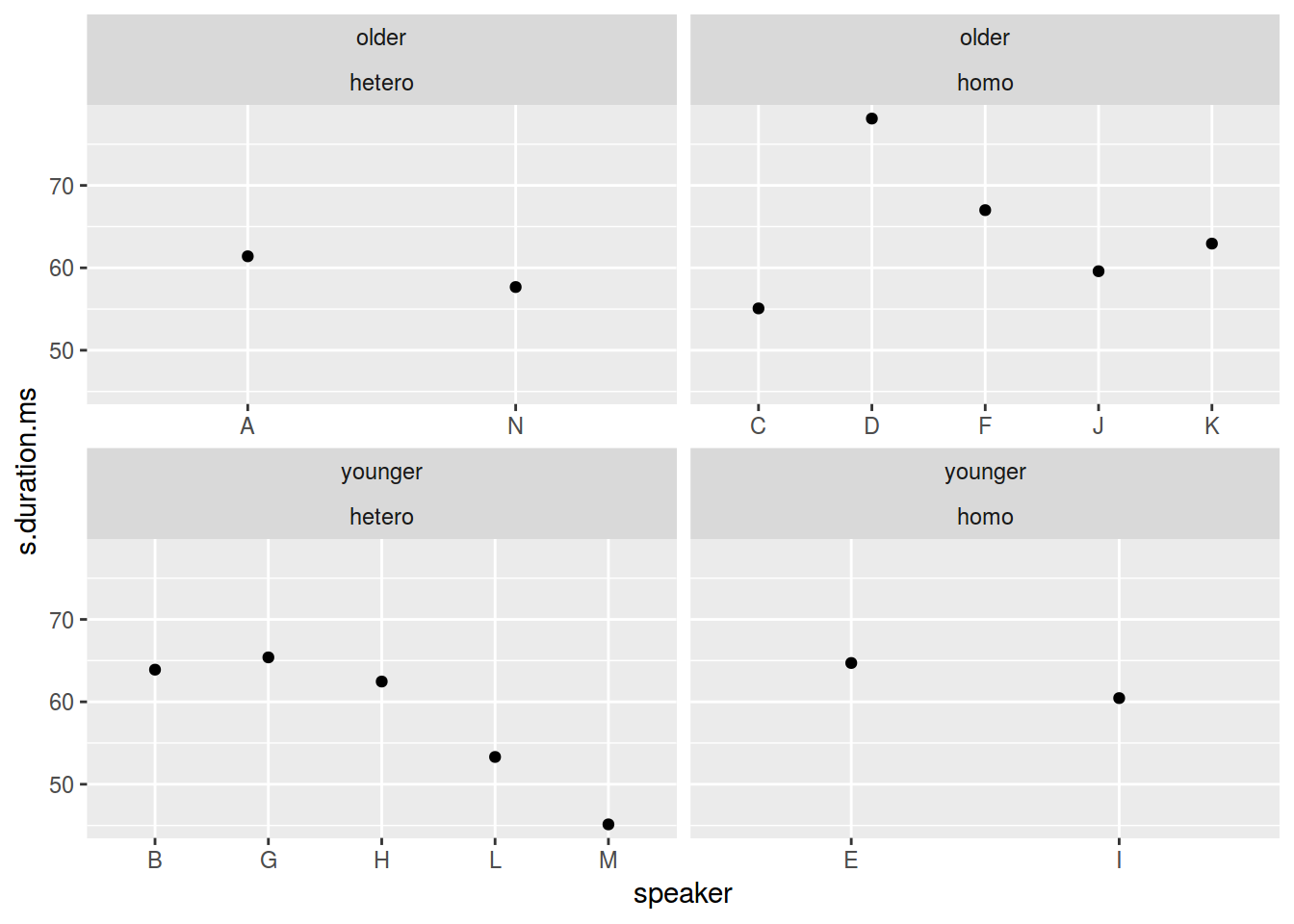
homo %>%
mutate(older_then_28 = ifelse(age > 28, "older", "younger")) %>%
ggplot(aes(speaker, s.duration.ms))+
geom_point() +
facet_grid(older_then_28~orientation, scales = "free_x")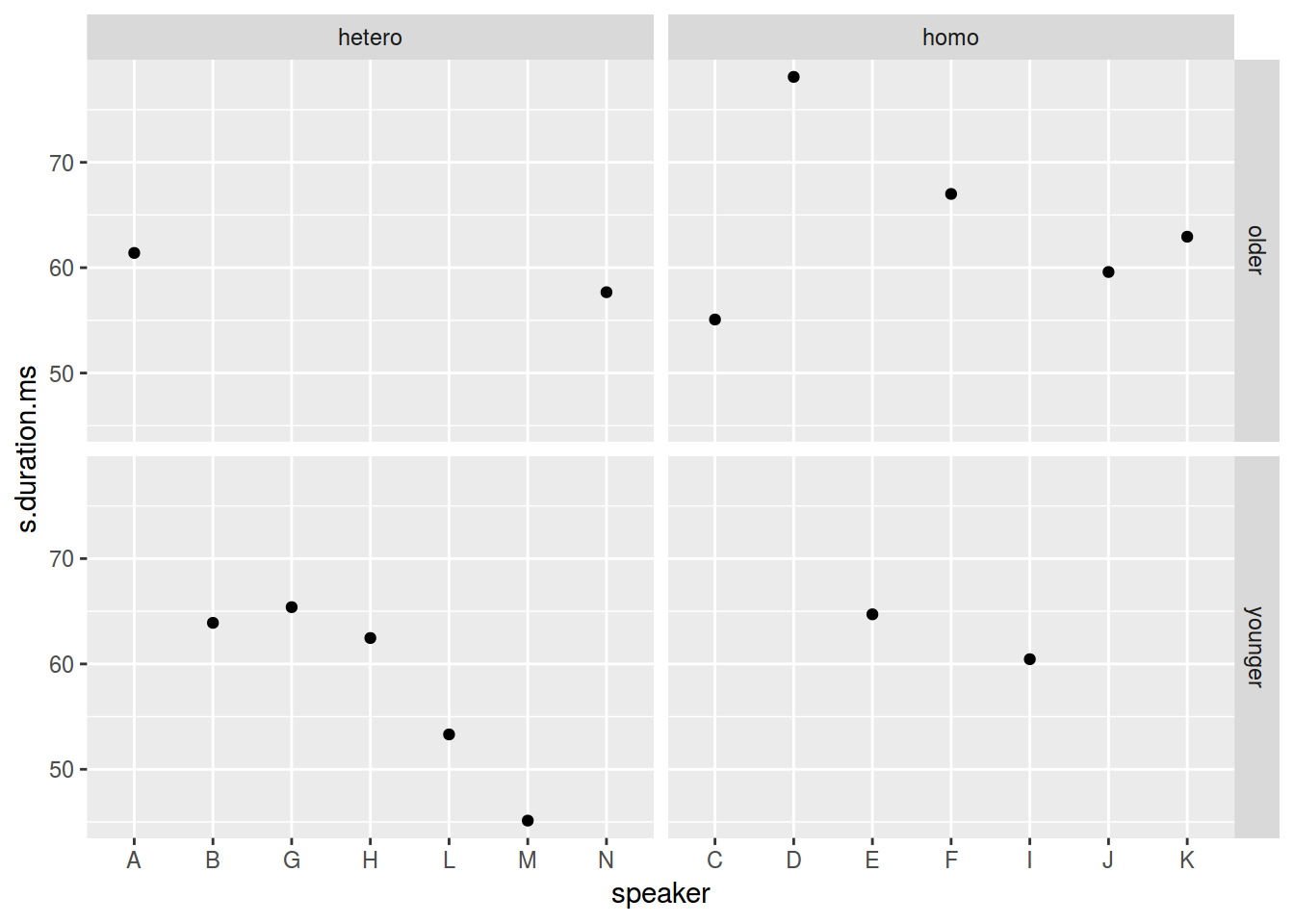
Существует еще славный аргумент margins.
homo %>%
mutate(older_then_28 = ifelse(age > 28, "older", "younger")) %>%
ggplot(aes(speaker, s.duration.ms))+
geom_point() +
facet_grid(older_then_28~orientation, scales = "free_x", margins = TRUE)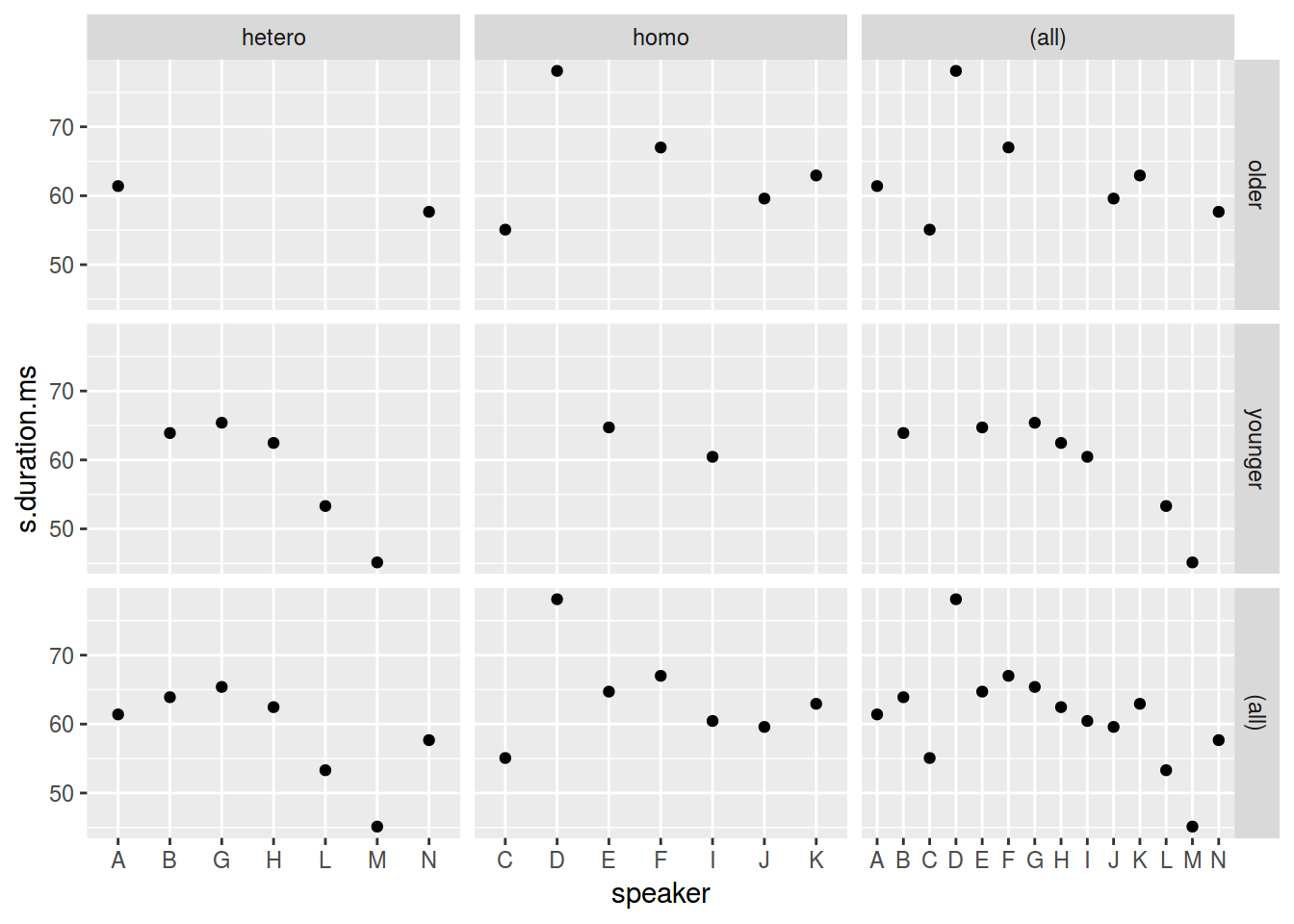
Иногда, очень хорошо показывать все данные на каждом фасете:
homo %>%
ggplot(aes(speaker, s.duration.ms))+
# Add an additional geom without facetization variable!
geom_point(data = homo[,-9], aes(speaker, s.duration.ms), color = "grey") +
geom_point() +
facet_wrap(~orientation)+
theme_bw()